원제 : How to Die (2018년)
다음
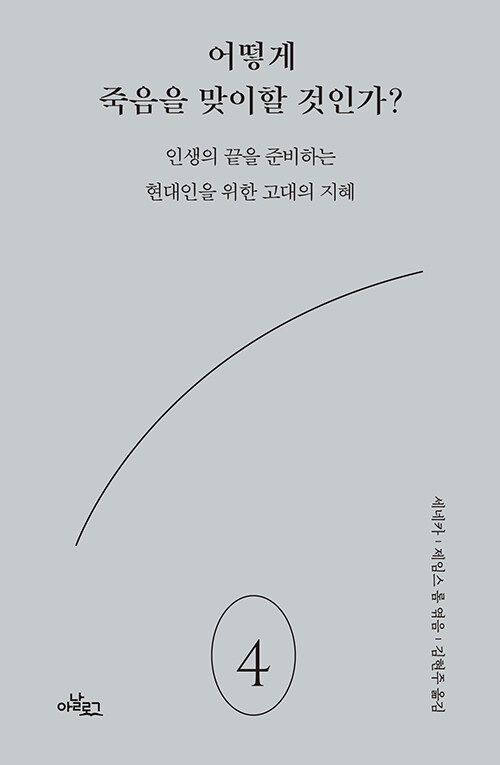












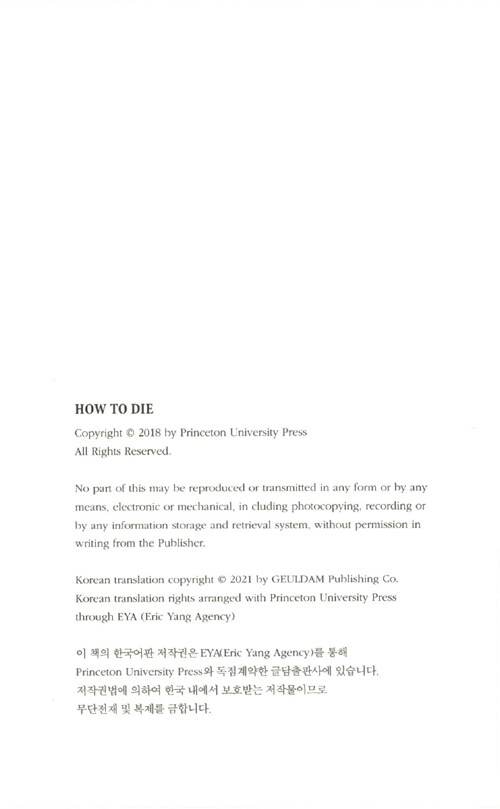



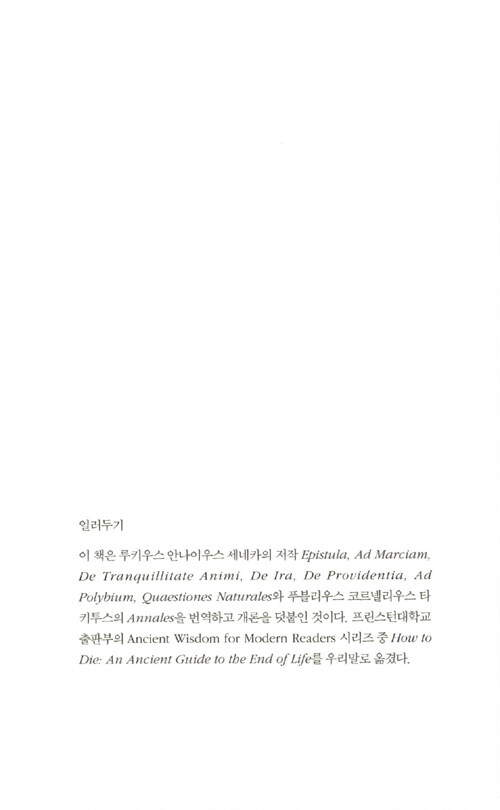







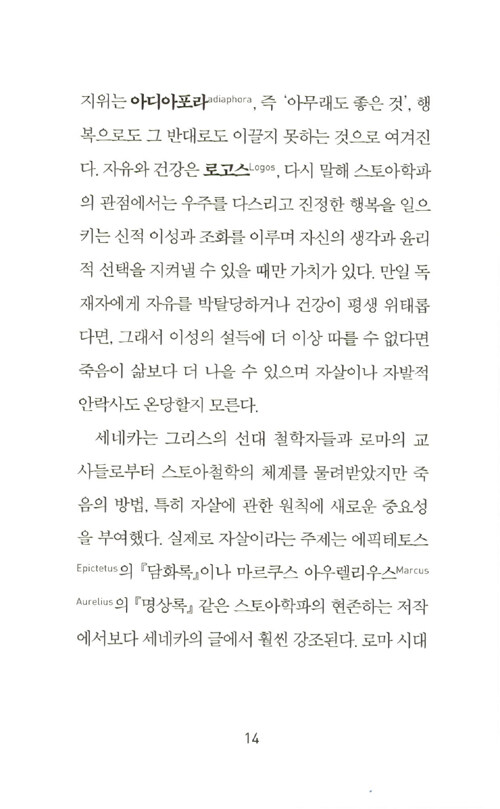
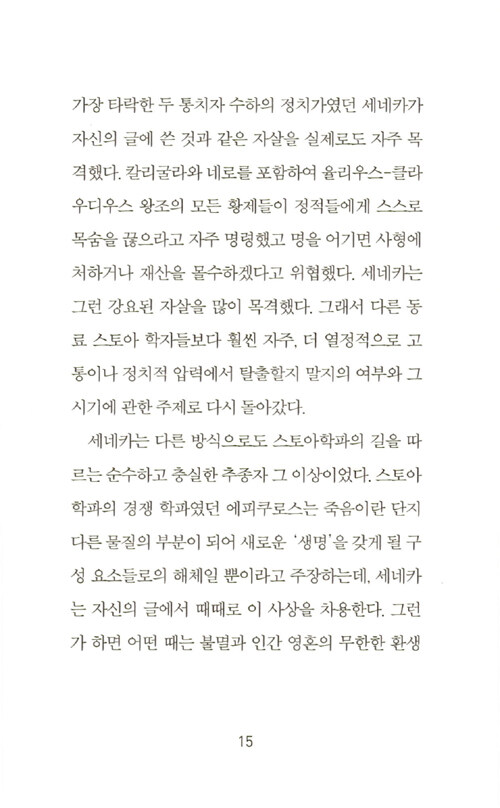
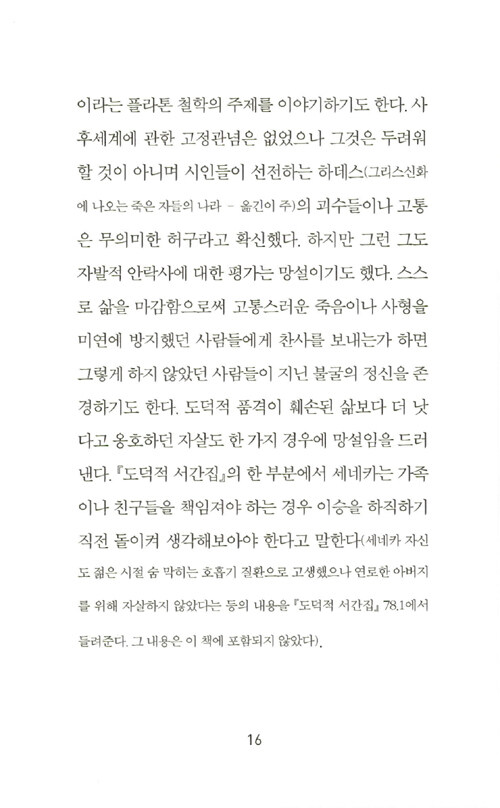
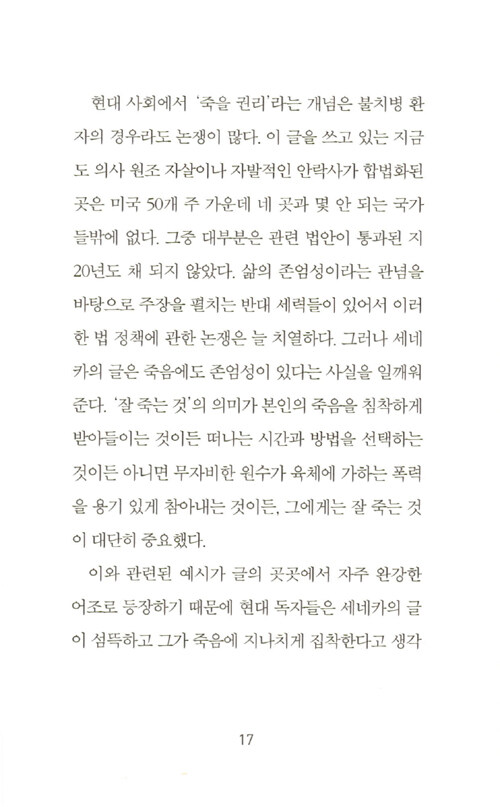

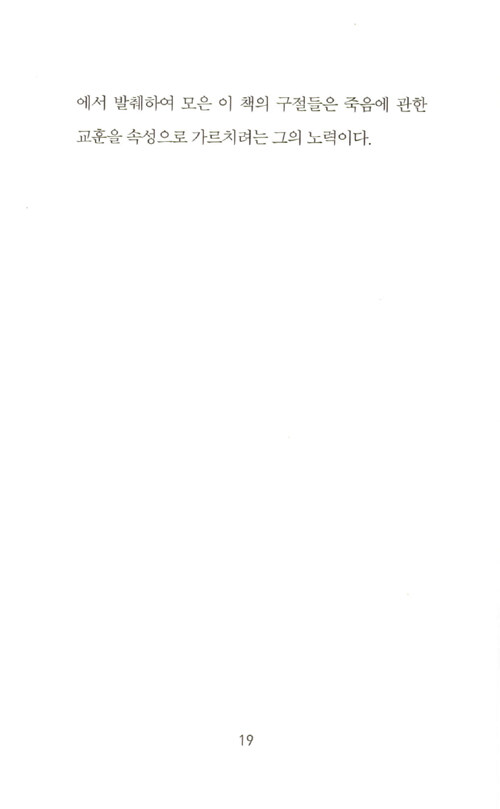

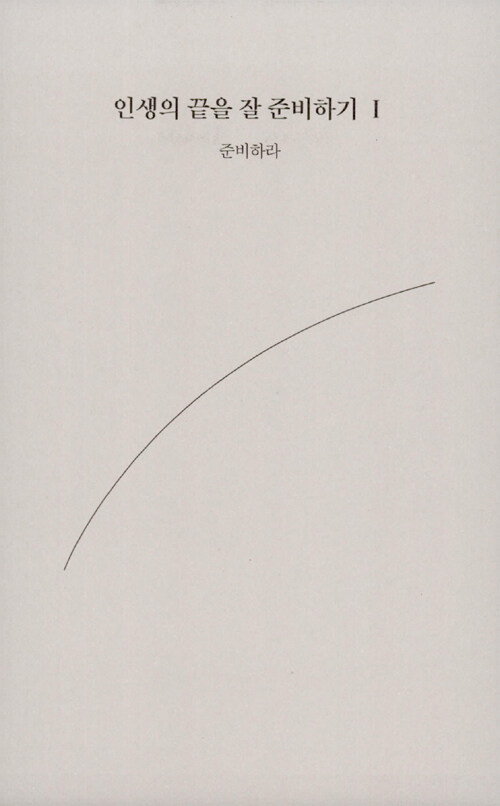


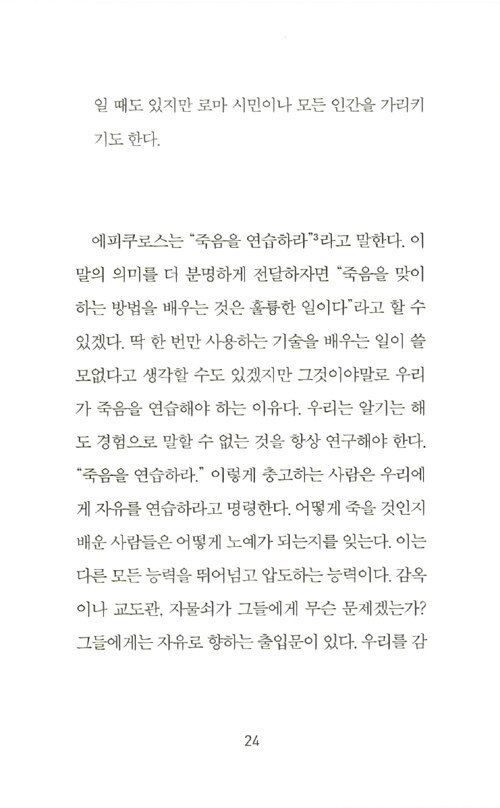
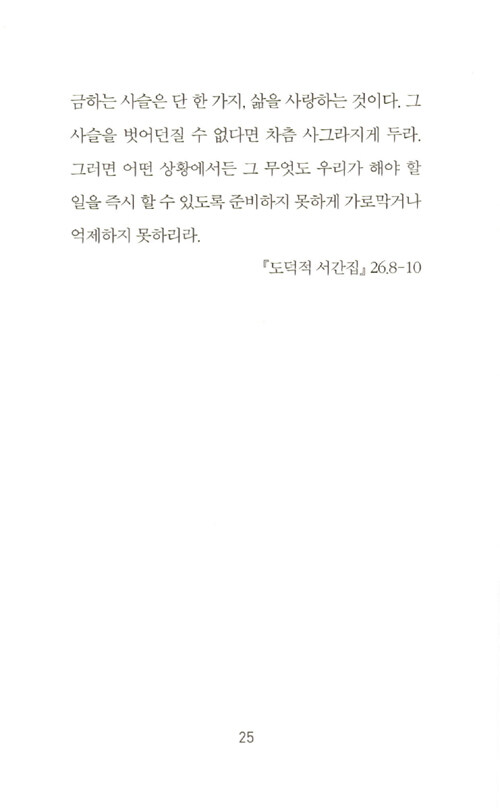


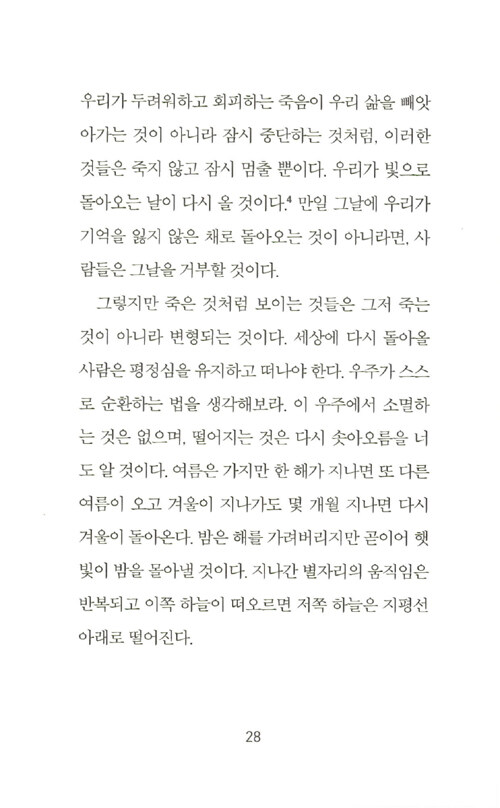
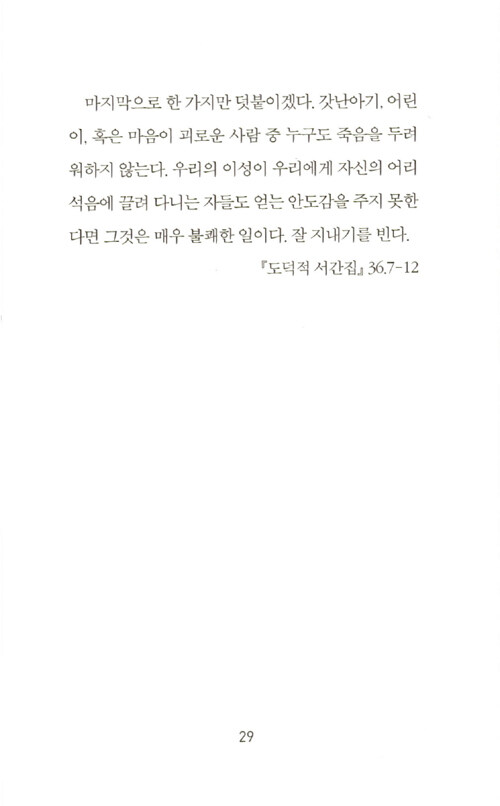
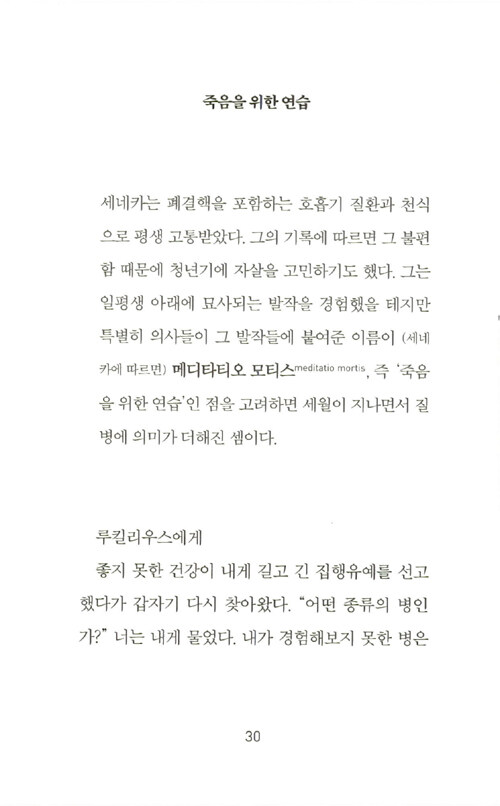
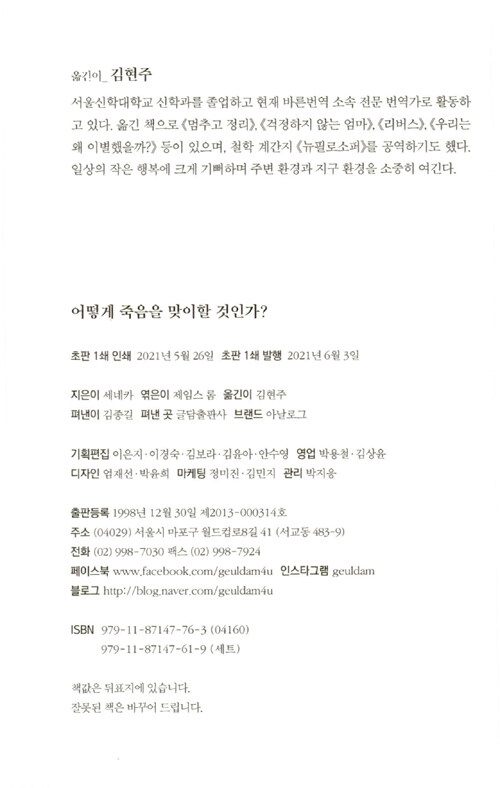
 미리보기
미리보기
정가
12,000원
판매가
10,800원 (10%, 1,200원 할인)
마일리지
600원(5%) + 멤버십(3~1%)
+ 5만원이상 구매시 2,000원
배송료
유료 (도서 1만5천원 이상 무료)
311
양탄자배송
지금 주문하면 내일 밤 11시 잠들기전 배송
(중구 서소문로 89-31 기준) 지역변경
Sales Point : 408
 9.3 100자평(1)리뷰(2)
9.3 100자평(1)리뷰(2)
이 책 어때요?
카드/간편결제 할인
무이자 할부
소득공제 490원
수량


장바구니 담기
바로구매
선물하기
보관함 +
전자책 출간알림 신청
중고 등록알림 신청
중고로 팔기



기본정보
양장본
176쪽
110*170mm
241g
ISBN : 9791187147763
주제 분류
신간알리미 신청
국내도서 > 인문학 > 서양철학 > 고대철학 > 고대철학 일반
출판사 제공 카드리뷰





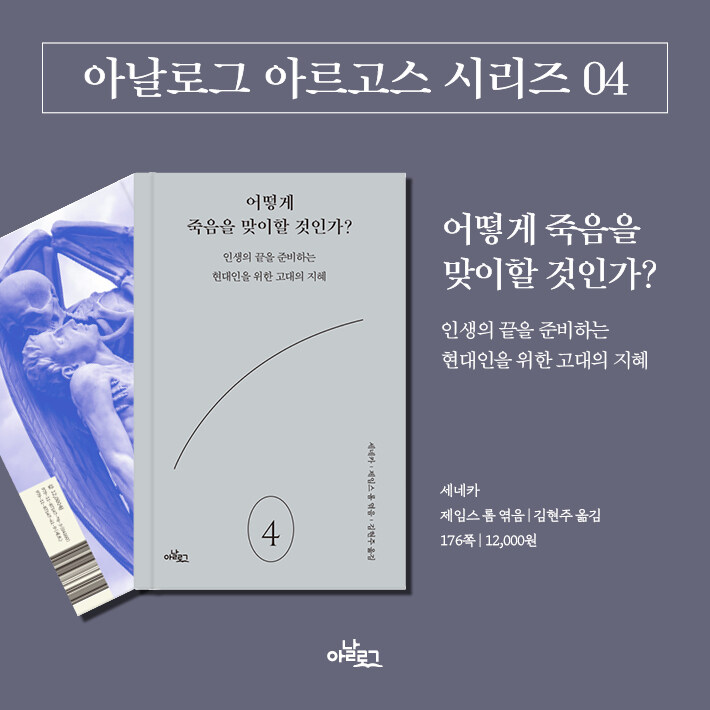
다음
이전
책소개
‘현대 독자가 질문하고 고대 철학자가 답하다!’ 프린스턴대 ‘현대 독자를 위한 고대의 지혜’×아날로그 아르고스 시리즈. 어떻게 분노를 다스릴 것인가? 어떻게 정신의 자유를 얻을 것인가? 어떻게 나이 들어야 하고, 또 어떻게 죽음을 준비해야 할 것인가? 진실된 우정은 어떻게 쌓을 수 있으며, 어떻게 하면 대화를 잘할 수 있는가? 때때로 사람들은 먹고사는 문제를 벗어나 근본적으로 더 나은 삶을 위한 질문을 던질 때가 있다. 그렇다면 이런 질문에 대한 답은 어디서 구할 수 있을까?
아날로그 아르고스 시리즈는 그 답을 고대 철학에서 찾는다. 이 시리즈는 프린스턴대학교 출판부가 기획하고 고전 철학의 저명한 학자들이 세네카, 키케로 같은 고대 철학자의 삶과 글에서 찾아낸 지혜를 엮은 <현대 독자를 위한 고대의 지혜 시리즈>를 우리말로 옮긴 것이다. 독자들은 이 책을 통해 2,000년이 흘러도 여전히 유의미한 인생의 기술을 만날 수 있다.
『어떻게 죽음을 맞이할 것인가?』는 아날로그 아르고스 시리즈의 네 번째 책이다. 고대 로마의 철학자이자 정치가인 루키우스 안나이우스 세네카는 평생 죽음을 맞이하는 방법에 대해 고민했지만, 이를 한 권의 책으로 정리하지는 않았다. 고대 그리스 로마 문화와 문명을 연구한 제임스 롬은 세네카의 사상을 담은 여덟 권의 저작에서 죽음에 관해 다룬 부분만을 뽑아, 풍성한 주석을 더해 새롭게 구성했다. 이 책을 통해 현대의 독자들은 평생에 걸쳐 죽음을 탐구한 세네카의 눈부신 사상을 엿볼 수 있을 것이다.
목차
들어가기에 앞서_세네카와 죽음에 대한 탐구
인생의 끝을 잘 준비하기 Ⅰ - 준비하라
인생의 끝을 잘 준비하기 Ⅱ - 두려워하지 말라
인생의 끝을 잘 준비하기 Ⅲ - 후회하지 말라
인생의 끝을 잘 준비하기 Ⅳ - 스스로에게 자유를 주라
인생의 끝을 잘 준비하기 Ⅴ - 전체의 부분이 되어라
에필로그_가르침을 실천하라
엮은이 주
책속에서
첫문장
세네카의 가장 위대한 산문 작품 『도덕적 서간집』은 절친한 친구 루킬리우스에게 보내는 편지 모음집이다.
P. 71~72 “우리는 죽고 싶지 않은데 죽어야 하거나 죽어갈 때가 많다. 언젠가는 죽어야 함을 알지 못할 만큼 순진한 사람은 없지만 그 지점에 다다르면 다들 뒤돌아서고 떨며 애원한다. 그런데 누군가 지난 천 년 동안 살아 있지 못했던 것을 슬퍼하며 흐느끼고 있다면 너는 그 사람을 바보 중의 바보라고 생각하지 않겠는가? 만일 앞으로 천 년을 더 살지 못하기에 울고 있는 사람이 있다면 그도 똑같이 어리석은 자다. 그저 같은 것이다. 너는 과거에 존재하지 못했던 것처럼 미래에도 존재하지 못할 것이다. 과거나 미래는 네 것이 아니다.” 접기
P. 85~89 “어느 날이나 일어날 수 있는 일을 언젠가 일어나리라고 놀라워하는 것보다 더 어리석은 일이 있겠는가? 우리의 종점은 벗어날 수 없는 운명의 필연이 마련해둔 그곳에 고정되어 있다. 하지만 우리가 그 종점에서 얼마나 멀리 떨어져 있는지는 누구도 알지 못한다. 그러므로 마지막 바퀴를 돌고 있다고 생각하며 정신을 가다듬어보자.”
P. 112~113 “현자는 살 수 있는 만큼이 아니라 살아야 하는 만큼만 살 것이다. 그는 자기가 어디까지, 누구와, 어떻게 살며 무엇을 할지 고찰할 것이다. 얼마만큼이 아니라 어떤 종류의 삶이 자신의 삶인지에 관해 깊이 생각할 것이다. (…) 일찍 죽든 늦게 죽든 중요하지 않다. 잘 죽느냐 그렇지 못하느냐가 중요하다.”
P. 139 “우리에게도 죽음은 단지 분리다. 우리는 그저 눈앞에 있는 것들만 본다. 정신이 우둔하거나 육체의 노예가 된 자들은 그 너머에 있는 것을 내다보지 못한다. 다른 모든 것과 마찬가지로 삶과 죽음 역시 번갈아 가며 자리를 바꾸며, 만물을 제한하는 신의 손길은 결합된 것을 분리하고 분리된 것을 결합한다는 목표를 지향한다는 점을 앞서 생각하면 우리도 조금 더 용감하게 자신이나 가족의 최후를 감당하리라.” 접기
저자 및 역자소개
루키우스 안나이우스 세네카 (Lucius Annaeus Seneca) (지은이)
저자파일
신간알리미 신청

후기 스토아철학 대표 사상가. 고대 로마 철학을 대표하는 철학자이자 정치인이며, 시인이자 비극작가이다. 기원전 4년 에스파냐에서 태어났으며 로마에서 자라면서 수사학과 변론술, 철학을 공부했는데 특히 스토아 철학자들의 영향을 많이 받았다. 젊어서는 천식과 결핵을 앓았고, 우울증으로 자살 시도도 여러 차례 했다. 늦깎이로 정계에 입문하지만 8년간 코르시카 섬에서 유배 생활을 하게 된다. 다시 로마로 복귀할 때 본인의 의지와는 상관없이 그에게 맡겨진 직책은 어린 네로의 가정교사라는 숙명적인 자리였다. 결국 세네카는 5년 동안 네로의 가정... 더보기
최근작 : <세네카의 인생 수업>,<세네카 비극 전집 1~3 세트 - 전3권>,<세네카 비극 전집 3> … 총 597종 (모두보기)
제임스 롬 (James Romm) (엮은이)
저자파일
신간알리미 신청
1958년 뉴욕에서 태어나 예일대학교에서 고전을 전공하고 프린스턴대학교에서 박사학위를 받았다. 1990년부터 바드대학에서 그리스어 및 그리스 문학과 역사를 가르치고 있다. 지은 책으로 『매일 죽다: 네로의 궁정에서의 세네카Dying Every Day: Seneca at the Court of Nero』가 있고, 《뉴욕 리뷰 오브 북스》 《월스트리트저널》 등 다수의 잡지에 글을 기고하고 있다.
최근작 : <어떻게 죽음을 맞이할 것인가?>,<어떻게 분노를 다스릴 것인가?>,<알렉산드로스 제국의 눈물> … 총 36종 (모두보기)
김현주 (옮긴이)
저자파일
신간알리미 신청
서울신학대학교 신학과를 졸업하고 현재 바른번역 소속 전문 번역가로 활동하고 있다. 옮긴 책으로 《어떻게 죽음을 맞이할 것인가》, 《멈추고 정리》, 《걱정하지 않는 엄마》, 《리버스》, 《우리는 왜 이별했을까?》 등이 있으며, 철학 계간지 《뉴필로소퍼》를 공역했다. 일상의 작은 행복에 크게 기뻐하며 주변 환경과 지구 환경을 소중히 여긴다.
출판사 제공 책소개

고대 로마의 스토아 철학자 세네카에게 배우는
삶과 죽음에 대한 시대를 초월한 지혜
고대 로마의 스토아 철학자 세네카는 “죽는 법을 배우려면 평생이 필요하다”고 썼다. 그는 독자들에게 “항상 죽음을 탐구하라”고 충고했고, 평생 그에 대해 거듭 고민했다. 『어떻게 죽음을 맞이할 것인가』는 처음으로 세네카의 죽음에 대한 명상을 한 권으로 모은 책이다. 세네카가 죽음에 관해 쓴 최초의 글인 『마르키아에게 보내는 위로문』을 비롯하여 『마음의 평온에 대하여』, 『분노에 대하여』, 『섭리에 관하여』, 『폴리비우스에게 보내는 위로문』, 『자연 연구』 그리고 말년의 최고작 『도덕적 서간집』에 이르기까지, 세네카의 사상이 담긴 저작을 가려 엮였다.
세네카는 고대 로마의 철학자이면서 동시에 정치가였다. 그는 서기 30년대 말 로마 황제 칼리굴라가 미쳐가며 신뢰하지 않는 이들을 잔인하게 처형하던 시대에 젊은 원로원 의원을 지냈으며, 40년대 황제 클라우디우스 시대에는 정치 여론 조작을 위한 재판에서 사형을 선고받았으나, 감형되어 코르시카섬으로 추방당했다. 이후 어린 네로의 스승이 되어 그가 자신의 정적들에게 죽음을 명령하는 모습을 여러 번 목격하기도 했다. 세네카는 이렇게 강요된 죽음을 접하면서, 평생에 걸쳐 ‘어떻게 해야 잘 죽을 수 있는지’를 고민했다.
세네카는 여러 저작을 집필했으나, 죽음이라는 주제만을 고찰하는 저작을 하나로 묶어 남기지는 않았다. 그러나 동시대의 지인이나 친구와 나눈 편지 및 각종 저작을 통해 계속해서 죽음에 관해 언급했다. 그에게 죽음은 멀리 있는 운명이 아니라, 당장 내일이라도 닥쳐올지 모를 사건이었다. 심지어 청년기부터 폐결핵 등의 호흡기 질환과 천식으로 고통받았던 세네카는 육체의 쇠함과 늙어감, 그리고 그 뒤에 올 죽음에 대해서도 자주 생각할 수밖에 없었다.
-- 나는 마지막 순간에도 떨지 않을 것이다. 나는 준비되어 있다. 앞으로 남은 모든 날에 대해 전혀 생각하지 않는다. 사는 것이 즐겁더라도 죽기를 거부하는 사람을 칭찬하거나 따라 하지 말라. 내쫓기듯 떠나는 것에 무슨 덕이 있겠는가? 하지만 여기에도 덕이 있으니, 나는 내쫓길 테지만 그럼에도 나의 떠남을 받아들인다. 내쫓긴다는 것은 떠나는 자리에서 본의 아니게 추방당하는 것이기에 현자는 절대 내쫓기지 않는다. 현자는 모든 일을 본의 아니게 하지 않는다. 그는 필연에서부터 벗어난다. 왜냐하면 그는 필연이 강요하는 죽음을 염원하기 때문이다. _p33~34
오래 사는 것이 반드시 좋은 일일까?
평균수명 120세 시대를 앞둔 현대인이 반드시 알아야 할 죽음에 대한 철학!
평균수명 100세 시대를 넘어, 이제는 120세까지도 살 수 있다는 전망이 점차 현실화되고 있다. 의학의 발달로 인해 과거에는 불치병으로 여겨지던 질병조차 극복하고 더 긴 수명을 누리게 되었지만, 과연 현대를 살아가는 인간이 이전보다 오래 산다고 더 행복한 삶을 누린다고 할 수 있을까? 한국의 현실을 보면 그 의문은 더 깊어질 수밖에 없다. 우리나라는 세계적으로 의료 서비스가 잘 정비되어 있는 국가로 질병 치료가 어렵지 않고 비용도 비교적 저렴하지만, OECD 국가 가운데 자살률 1위라는 불명예를 함께 안고 있기도 하다. 이러한 상황에서 고대 로마 시대의 철학자 세네카가 던진 “어떻게 해야 죽음을 잘 맞이할 수 있는가”라는 질문은 현대인에게도 던지는 의미가 크다.
『어떻게 죽음을 맞이할 것인가』에서는 죽음에 대해 놀라울 정도로 솔직하게 말하는 도발적인 사상가이자 눈부신 작가인 세네카의 진면목을 살펴볼 수 있다. 세네카는 『인생의 짧음에 대하여』에서 이렇게 말했다. “일평생 잘 사는 방법을 배워야 한다. 뜻밖이라 생각할 수 있겠지만, 일평생 잘 죽는 방법도 배워야 한다.” 세네카는 인생이란 죽음을 향한 여행일 뿐이며, 살아가는 동안 평생 죽음을 위한 예행연습을 해야 한다고 믿었다. 수명이 짧든 길든 간에 인간은 반드시 죽음을 맞이할 수밖에 없는 운명이며, 따라서 죽음은 인생의 마지막 통과의례이면서 동시에 삶의 본질적인 요소라는 것이다. 그는 삶을 제대로 살기 위해서는 죽음이 반드시 필요하며, 어떻게 해야 죽음을 잘 맞이할 수 있는지를 고민해보아야 한다고 거듭 주장한다.
-- 딱 한 번만 사용하는 기술을 배우는 일이 쓸모없다고 생각할 수도 있겠지만 그것이야말로 우리가 죽음을 연습해야 하는 이유다. 우리는 알기는 해도 경험으로 말할 수 없는 것을 항상 연구해야 한다. “죽음을 연습하라.” 이렇게 충고하는 사람은 우리에게 자유를 연습하라고 명령한다. 어떻게 죽을 것인지 배운 사람들은 어떻게 노예가 되는지를 잊는다. 이는 다른 모든 능력을 뛰어넘고 압도하는 능력이다. _p24
세네카는 고통이나 예속, 또는 억압으로부터 우리를 해방시키는 수단으로써의 죽음에 대해서도 자주 이야기한다. 독재자에게 자유를 박탈당하거나 건강이 위태롭다면 죽음이 삶보다 더 나을 수 있으며, 자살이나 자발적인 인락사도 필요하다는 것이다. 당대의 폭군들이 정적들을 제거하는 모습을 수도 없이 보아온 세네카에게는 죽음이 자유로 가는 길이기도 했다. 현대에도 격렬한 논쟁의 주제가 되는 의사의 원조 자살이나 자발적 안락사 등 ‘존엄하게 죽을 권리’에 대한 개념은 고대 로마 시대에도 있었던 셈이다. 그러나 이처럼 단호한 주장을 펼치는 가운데서도, 세네카는 가족이나 친구들을 책임져야 한다면 죽음을 다시 생각해보아야 할 수도 있다고 말한다.
-- 무엇보다도 떳떳한 감정이 채워져야 한다. 때때로 상황에 억눌려도 영혼을 다시 불러와야 하고 고통스럽다 하더라도 가깝고 사랑하는 이들을 위하여 입술에 맴도는 영혼을 붙들어야 한다. 선한 사람은 원하는 만큼이 아니라 살아야 하는 만큼 살아야 한다. 자기 아내나 친구들이 삶을 더 오래 지속하게 할 만한 가치가 없다고 판단하고 죽기로 결심한 사람은 너무 까다로운 것이다. 영혼이 죽고 싶을 뿐 아니라 이미 죽기 시작했더라도 잠시 멈추고 가족과 친구들의 필요를 채워주려 해야 한다. 다른 이를 위해 삶으로 돌아온다는 것은 위대한 영혼의 표징이며 위대한 사람은 그렇게 행동한다. _p125~126
세네카는 황제 암살 음모에 공모했다는 혐의로 네로의 분노를 사, 서기 65년 60대의 나이로 자살하라는 형을 선고받았다. 에필로그에는 이러한 세네카의 자살을 묘사한 타키투스의 『연대기』가 포함되어, 현대의 독자들에게 죽음을 맞이하는 방법에 대해 다시금 생각해보게 한다. 접기





책을 통해 죽음 이면에서 삶답게 살아내는 최선에 대해, 보이지 않는 두려움을 털어내고 자연의 순환과 과정의 일부를 인정함을 생각해 보게 되었다.
마음이동하는아동 2021-06-13 공감 (0) 댓글 (0)





‘죽음‘에 대한 세네카의 생각들 <어떻게 죽음을 맞이할 것인가?>
인생의 끝을 준비하는 현대인을 위한 고대인의 지혜
세네카는 고대로마의 스토아 철학자 이다. 얼마전 읽었던 세네카의 에세이집 글들은 '삶'에 대한 이야기였다면 이 책은 '죽음'에 대한 세네카의 글을 모은 책이다. 삶과 죽음은 모든 인간에게 주어진 가장 중요한 화두라고 할 수 있다. 어떻게 살 것인가? 어떻게 죽을 것인가? 는 늘 지혜를 필요로 하는 질문들이다. 그 지혜를 오랜 세월 전해져온 고대인의 글에서 배워볼 수 있기를...
그는 삶을 제대로 인식한다면 인생은 죽음으로 가는 여정일 뿐이며 인간은 태어나는 날부터 매일 죽어가기에 살아가면서 죽음을 연습해야 한다고 주장한다. 이 책은 세네카의 사상이 담긴 여덟 권의 저작에서 가려 엮은 것으로, 이 글을 통해 세네카는 자신의 편지 수신인과 인류에게 죽음, 즉 사람의 생이 끝나는 지점을 받아들일 필요성에 대해 당시나 지금이나 유례없을 만큼 솔직하게 이야기 한다. (p. 10)
이 책은 세네카의 에세이 전문을 실은 것이 아니라 부분적으로 내용을 옮겨와 엮은 것이다. 그 엮은 주제는 하나 '죽음' 이다.
철학자인 동시에 정치가였던 세네카는 AD30년대 말 로마 황제 칼리굴라가 미쳐가며 잔인하게 굴던 시대에 젊은 원로원 의원을 지냈다. 40년대 황제 클라우디우스 시대에는 정치적 여론 조작용 재판으로 사형을 선고받았으나 감형되어 코르시카 섬으로 추방당했다. 이후 로마로 환송 명령을 받고 어린 네로의 스승이 된 세네카는 50년대부터 60년대 초까지 황실에서 지냈다. 그는 점점 정신이 이상해져 심지어 가족들까지 죽이려는 네로의 모습을 지켜보았다. 결국 미수에 그쳤던 황제 암살 음모에 공모했다는 혐의로(아마도 잘못된 혐의였을 것이다) 네로의 분노를 사서 AD65년, 60대의 나이에 자살하라는 형을 선고받았다. (p. 12)
세네카가 살았던 시대는 그야말로 광적인 황제들의 시대였다. (한마디로 멀쩡한 정신의 황제를 경험해보지 못했다고나 할까) 죽음이 난무했고 고문과 사형이 아닌 자살형은 차라리 축복이었다. 고전을 전공하고 그리스문학과 역사를 가르치는 저자는 세네카가 '그리스의 선대 철학자들과 로마의 교사들로부터 스토아철학의 체계를 물려받았지만 죽음의 방법, 특히 자살에 관한 원칙에 새로운 중요성을 부여했다. (p. 14)' 고 말한다. 하지만 세네카가 말하는 자살과 현대적 의미의 자살은 구분지어 생각할 필요가 있다. 세네카는 '자신의 글에 쓴 것과 같은 자살을 실제로도 자주 목격했다. 칼리굴라와 네로를 포함하여 율리우스-클라우디우스 왕조의 모든 황제들이 정적들에게 스스로 목숨을 끊으라고 자주 명령했고 명을 어기면 사형에 처하거나 재산을 몰수하겠다고 위협했다. 세네카는 그런 강요된 자살을 많이 목격해다. 그래서 다른 동료 스토아 학자들보다 훨씬 자주, 더 열정적으로 고통이나 정치적 압력에서 탈출할지 말지의 여부와그 시기에 관한 주제로 다시 돌아갔다. (p. 15)' 과거의 모든 기록은 당시의 상황을 감안해서 읽어야 한다. 스토아철학자로서 정치계에 있었던 세네카의 현실은 그의 철학적 주제를 그가 경험하고 목격하는 현실속에서 찾게 만들었다.
세네카의 글은 죽음에도 존엄성이 있다는 사실을 일깨워 준다. '잘 죽는 것'의 의미가 본인의 죽음을 침착하게 받아들이는 것이든 떠나는 시간과 방법을 선택하는 것이든 아니면 무자비한 원수가 육체에 가하는 폭력을 용기 있게 참아내는 것이든, 그에게는 잘 죽는 것이 대단히 중요했다. (p. 17)
세네카의 현실은 늘 죽음을 목전에 두고 있는 상황이었다. 하지만 늘 마음 졸이며 위기의식 속에 살았다기 보다는 스토아철학자로서 '잘 죽는 것'에 대해 고민하고 생각했다. 저자는 '세네카가 약25년에 걸쳐 쓴 산문 중 죽음을 가장 중요하게 다룬 여덟 편의 산문에서 발췌하여 모은 이 책의 구절들은 죽음에 관한 교훈을 속성으로 가르치려는 그의 노력이다. (p. 18)' 라고 말했다. 그가 처했던 현실을 상상해보고 그가 남긴 말들을 읽어보며 그가 선택한 죽음에 대해 그는 과연 죽음을 잘 맞이했는지 판단해보는 것은 이 책을 읽는 의미중 하나가 될 수 있을 것같다.
친밀한 편지글 형식을 띠고 있지만 [도덕적 서간집]은 애초에 출판을 위해 쓰인 글이며 수신인인 '너'는 루킬리우스 일 때도 있지만 로마 시민이나 모든 인간을 가리키기도 한다. (p. 23)
에피쿠로스는 '죽음을 연습하라'라고 말한다. 이 말의 의미를 더 분명하게 전달하자면 '죽음을 맞이하는 방법을 배우는 것은 훌륭한 일이다' 라고 할 수 있겠다. 딱 한 번만 사용하는 기술을 배우는 일이 쓸모없다고 생각할 수도 있겠지만 그것이야말로 우리가 죽음을 연습해야 하는 이유다. 우리는 알기는 해도 경험으로 말할 수 없는 것을 항상 연구해야 한다. '죽음을 연습하라' 이렇게 충고하는 사람은 우리에게 자유를 연습하라고 명령한다. 어떻게 죽을 것인지 배운 사람들은 어떻게 노예가 되는지를 잊는다. (p. 24) [도덕적 서간집]
죽음에는 연습이 있을 수 없다. 죽음에 기술이 필요하다면 그야말로 단 한번의 기회에 사용되는 단 한번의 기술일 것이다. 그리고 살면서 유일하게 경험해 볼 수 없는 것이 바로 죽음이다. 그러니 연습해야 한다고 세네카는 말한다. 죽음을 생각하고 연습하는 것이 곧 무엇에도 노예로서 종속되지 않는 자유로운 삶이 될 것이라 말한다. 죽음을 연습하는 것은 곧 제대로 살아내는 것이기도 하다.
세네카는 폐결핵을 포함하는 호흡기 질환과 천식으로 평생 고통받았다. 그의 기록에 따르면 그 불편함 때문에 청년기에 자살을 고민하기도 했다. 그는 일평생 아래에 묘사되는 발작을 경험했을 테지만 특별히 의사들이 그 발작들에 붙여준 이름이 (세네카에 따르면) 메디타티오 모티스, 즉 '죽음을 위한 연습'인 점을 고려하면 세월이 지나면서 질병에 의미가 더해진 셈이다. (p. 30)
세네카의 정치적 상황속에서만 죽음의 그림자가 드리워져 있던 것이 아니었다. 세네카는 평생 폐질환으로 고통 받았고 그 병을 '죽음을 위한 연습' 이라고 불렀다. 죽고 싶을 만큼 고통스런 질병을 평생 앓으면서 수많은 죽음을 목격하고 자신도 언제 어느때 죽임을 당할지 모르는 삶이라니 당연히 '죽음'에 대해 생각하고 또 생각하게 되었을 것 같다. 이렇게보면 철학자로서 '잘 죽는 법'에 대해 고뇌하고 고뇌하게 된 것은 당연한 귀결이 아니었을까.
나는 준비되어 있다. 앞으로 남은 모든 날에 대해 전혀 생각하지 않는다. 사는 것이 즐겁더라도 죽기를 거부하는 사람을 칭찬하거나 따라 하지 말라. 내쫓기듯 떠나는 것에 무슨 덕이 있겠는가? 하지만 여기에도 덕이 있으니, 나는 내쫓길 테지만 그럼에도 나의 떠남을 받아들인다. 내쫓긴다는 것은 떠나는 자리에서 본의 아니게 추방당하는 것이기에 현자는 절대 내쫓기지 않는다. 현자는 모든 일을 본의 아니게 하지 않는다. 그는 필연에서 벗어난다. 왜냐하면 그는 필연이 강요하는 죽음을 염원하기 때문이다. (p. 33)[도덕적 서간집 54]
이 책에 자주 인용되는 [도덕적 서간집]은 세네카가 죽기직전 마지막으로 남긴 에세이라고 한다.(p. 141 참고) 네로에게 퇴출당하고 칩거하는 동안 당연히 곧 다가올 자신의 '죽음'을 예감하지 않았을까, 그렇게 자신의 죽음을 준비할 수밖에 없지 않았을까. 어차피 죽을 거 편안하게 최선을 다해 잘 맞이하고 싶지 않았을까.
죽음은 관습적으로 경멸당하는 것 이상으로 경멸당해야 한다. 우리는 죽음에 대한 많은 것을 의심 없이 받아들인다. 그런데 수많은 재주꾼은 죽음에 관한 나쁜 평판을 퍼뜨리려고 노력하며 지하감옥, 영원한 밤으로 뒤덮인 왕국 등으로 죽음을 묘사한다. (p. 55) 그런데 이 이야기들이 우화에 불과하며 사후세계에는 죽은 자들을 두렵게 하는 것이 아무것도 없음을 안다 해도 또 다른 공포가 존재한다. 사람들은 지하세계에 존재하는 것을 두려워하는 만큼 어디에도 존재하지 않는 것을 두려워하기 때문이다. (중략) 죽음이 악한 것이라고 생각한다면 정신은 덕을 얻지 못하겠지만 죽음을 아무래도 좋은 것으로 여긴다면 가능할 것이다. (p. 56) [도덕적 서간집 82]
세네카는 사후세계를 믿지 않았다. 사후세계에 대한 묘사들은 다 우화이고 거짓이라고 한다. 존재하지 않기때문에 두려워하는 것이라고 말한다. 잘 죽는 것은 사후세계를 위한 준비를 하라는 의미가 아니다. 죽음은 악한 것도 아니고 두려운 것도 아니다. 세네카는 자신의 죽음에 직면하기 위해 무수히 노력했던 것 같다.
나는 젊었을 때는 잘 사는 것에 관심을 두었고 늙어서는 잘 죽는 것에 신경쓰고 있다. 잘 죽는 것이란 기꺼이 죽는 것을 의미한다. 상황이 무엇을 요구하든 그것을 기대하며, 무엇보다 슬픔을 배제하고 죽음을 응시하기로 마음을 가다듬자. 우리는 삶을 준비하기 이전에 죽음에 대비해야 한다. 삶이 이미 잘 갖추어져 있는데도 우리는 더 채워 넣으려고 욕심낸다. 항상 무언가 부족해 보이고 앞으로도 계속 그래 보일 것이다. 그러나 충분히 살았음을 결정하는 것은 햇수도 아니고 날수도 아니고 정신이다. 소중한 루킬리우스, 나는 충분히 오래 살았다. 나는 마음 가득 죽음을 기다린다. (p. 67) [도덕적 서간집 61]
세네카는 내내 죽음을 이야기하지만 그런 이야기를 하는 동안 머릿속에선 자신의 삶이 스쳐지나가고 있지 않았을까?
우리는 오래 사는 것이 아니라 충분히 사는 것에 관심을 두어야 한다. 왜냐하면 오래 살게 돕는 것은 운명이지만 충분히 살게 돕는 것은 자기 자신의 정신이기 때문이다. 삶은 충만하다면 길 것이며, 정신이 자신의 선을 스스로 되찾고 통제할 때 삶은 충만해진다. 느리게 지나가는 80년 세월이 어찌 특권이겠는가? 사는 것이 아니라 삶을 버티는 것이다. 늦게 죽는 것이 아니라 오래 죽어가는 것이다. (p. 78) 얼마나 살아야 완전하겠느냐고 네가 물었다. 지혜를 얻을 때까지 사는 것이다. 그 목표에 도달한 사람은 가장 먼 지점이 아니라 가장 위대한 지점에서 인생을 끝맺는다. (p. 80) [도덕적 서간집 93]
세네카는 수명에 연연해하지 말라고 말한다. 짧게 살다간 이의 죽음을 슬퍼할 것도 없고 장수하는 이의 삶을 부러워할 것도 없다고 말한다. 중요한 것은 충분히 충만하게 사는 것이다. 세네카는 자신의 죽음을 기다리며 자신의 삶에 대해 이러한 만족감으로 위안을 얻고 싶었던 것이 아닐까. 좀더 편안한 마음으로 죽음을 맞이할 수 있도록. 아무리 괜찮은 척 해도 결국은 죽음이 두려웠기에 끊임없이 생각하고 또 생각하며 용기를 가지려 했던 것이 아닐까. 고찰하고 또 고찰하며 용기와 지혜를 갖춘 현인이 되고 싶었던 것이 아닐까. 마치 소크라테스처럼.
소크라테스는 독을 마시지 않고 식음을 전폐하며 금욕함으로써 생을 마감할 수도 있었다. 그러나 그는 감옥에서 30일 동안 죽음을 기다렸다. 모든 가능성을 열려 있다는 - 그렇게 긴 기간이라면 온갖 종류의 희망의 방이 마련되어 있을지도 모른다는-믿음에서가 아니라 법에 복종하며 친구들이 자신의 최후의 날에 기쁨을 얻게 하기 위해 서였다. 죽음을 경멸하면서도 독배를 두려워하는 것보다 더 바보 같은 일은 없으리라. (p. 114) [도덕적 서간집 70]
소크라테스는 죽음을 경멸하지도 않았고 독배를 두려워 하지도 않았다. 앞서서 '죽음은 관습적으로 경멸당하는 것 이상으로 경멸당해야 한다. (p.55)' 라는 문장을 보면 세네카는 죽음을 경멸했던 것도 같다. 경멸하는 것 앞에서 당당하기 위해 죽음을 아무렇지 않은 것으로 생각하려 했던 것일까. 죽음을 기다린다고 말하면서도 내심 더 살고 싶은 욕망을 내려놓기가 힘들었던 것인지도...
도둑과 적군 모두 네 목에 칼을 꽂을 수 있음을 기억하라. 권력자는 물론이거니와 노예에게도 네 삶과 죽음의 권한이 있을 수 있다. 공공연한 공격이든 비밀 모의를 통해서는 집안에서 배신당해 몰락한 자들의 일화를 생각해보라. 왕보다 노예의 증오에 의해 무너졌던 사람이 적지 않다는 사실을 알게 될 것이다. (p. 144) [도덕적 서간집 4]
왕뿐만 아니라 노예에 의해서도 죽임을 당하던 시대였다. 세네카는 네로황제에 의해서도 죽음을 당할수 있고 집안에서 부리던 노예에 의해서도 죽음을 당할수 있었다. 그래서인지 세네카는 노예에 대해 비교적 관대한 입장을 가졌던 철학자였다. '노예상태는 정신의 상태가 아닌 육체의 상태이며, 노예는 영혼의 자유를 통해 육체의 예속을 초월할 수 있다' 고 말했던 세네카가 두려워 했던 존재는 결국 자신을 내친 네로황제 뿐이었던 것 같다. 그러니 잔인한 처형이 아니라 자살형이 내려졌을때 오히려 감사한 마음이 들지 않았을까. 그래서 자신의 죽음을 소크라테스의 죽음과 견줄만한 모습으로 연출할 수 있었던 것이 아닐까.
세네카는 플라톤이 [파이돈]에서 각색한 장면 중 죽음을 차분하게 마주했던 소크라테스의 모습을 매우 동경했다. (중략) 타키투스의 역사서 [연대기]에 실린 아래의 본문에 세네카의 죽음에 대한 기록이 전해져 내려온다. 세네카의 자살은 복잡다단했고, 타키투스의 기록은 플라톤이 남긴 소크라테스의 마지막 이야기만큼 긍정적이지는 않다. 세네카가 성인이 되고 나서 내내 생각하고 준비했던 그 죽음을 실제로 이루어냈는지는 독자들이 스스로 판단할 수 있을 것이다. (p. 154~155))
타키투스의 [연대기]에서 세네카의 죽음 장면만 찾아 읽어봤었다. 이 책의 저자가 말한것처럼 세네카의 죽음은 소크라테스의 죽음 같은 감동적인 장면은 아니었다. 세네카가 알려주는 고대의 지혜는 결국 인간은 누구나 다 거기서거기라는 것 아닐까? 평생 죽음에 대해 성찰하고 현인이 되고자 했던 세네카와 죽음을 생각지 않고 삶에 치중하는 현대인은 다를 것이 별로 없어 보였다. 그러니 우리가 세네카로부터 배워야 하는 것은 간단하게 말하면 '메멘토 모리' 가 아닐런지.
우리는 어느 순간 부득이하게 삶을 떠나야 하고 마지막 숨을 내쉬어야 하기에, 조금 더 거창한 이유로 죽는 것은 일종의 기쁨이다. 우리는 언젠가 어디선가 반드시 죽는다. (p. 152) [자연 연구 6]
그저 오래 사는 것에 대해 세네카는 ' 사는 것이 아니라 삶을 버티는 것이다. 늦게 죽는 것이 아니라 오래 죽어가는 것이다.' 라고 했다. 산다는 것이 오래 죽어가는 것이 아니라 얼만큼 살든 충만하게 사는 것이 될 수 있도록 세네카의 문장에서 지혜를 찾아보는 건 어떨까? 우리는 모두 언젠가 어디선가 반드시 죽을 테니까 말이다.
- 접기
LILLY 2021-06-10 공감(2) 댓글(0)
Thanks to
공감





웰다잉의 지혜
경건한 마음으로 웰다잉의 자세를 접했습니다.무엇보다 고대인의 지혜를 사례로 간접 경험을 해보니예나 지금이나 웰다잉은 존재했구나 라는 것을 느낍니다.
ysalesio 2021-06-14 공감(0) 댓글(0)
Thanks to
공감
How to Die: An Ancient Guide to the End of Life by Seneca | Goodreads

Ancient Wisdom for Modern Readers
How to Die: An Ancient Guide to the End of Life
Seneca, James S. Romm (Editor)
4.06
2,025 ratings279 reviews
Want to read
Buy on Kobo
Rate this book
Edit my activity
“It takes an entire lifetime to learn how to die,” wrote the Roman Stoic philosopher Seneca (c. 4 BC–65 AD). He counseled readers to “study death always,” and took his own advice, returning to the subject again and again in all his writings, yet he never treated it in a complete work. How to Die gathers in one volume, for the first time, Seneca’s remarkable meditations on death and dying. Edited and translated by James Romm, How to Die reveals a provocative thinker and dazzling writer who speaks with a startling frankness about the need to accept death or even, under certain conditions, to seek it out.
Seneca believed that life is only a journey toward death and that one must rehearse for death throughout life. Here, he tells us how to practice for death, how to die well, and how to understand the role of a good death in a good life. He stresses the universality of death, its importance as life’s final rite of passage, and its ability to liberate us from pain, slavery, or political oppression.
Featuring beautifully rendered new translations, How to Die also includes an enlightening introduction, notes, the original Latin texts, and an epilogue presenting Tacitus's description of Seneca's grim suicide.
GenresPhilosophyNonfictionClassicsSelf HelpDeathHistoryPsychology
...more
230 pages, Hardcover
First published December 5, 2017
Book details & editions
Lucius Annaeus Seneca (often known simply as Seneca or Seneca the Younger); ca. 4 BC – 65 AD) was a Roman Stoic philosopher, statesman, and dramatist of the Silver Age of Latin literature. He was tutor and later advisor to emperor Nero, who later forced him to commit suicide for alleged complicity in the Pisonian conspiracy to have him assassinated.

Michael Perkins
5 books · 417 followers
Follow
October 23, 2022
“All of my plays are about people missing the boat, closing down too young, coming to the end of their lives with regret at things not done, as opposed to things done. I find most people spend too much time living as if they’re never going to die.”
― Edward Albee
===========
Laureen Powell Jobs, widow of Steve Jobs, has become an amazing philanthropist. Her father died when she was 3, and she says that growing up knowing that death can happen at a young age shaped her perspective. “What good stuff can I do that would be useful and meaningful? That is a driving force in my life.”
“So I understand the gift of each day—the gift that is life. We are not promised life and then we don’t know how long it is. So I’m able to cherish it and be really clear about what is my highest and best use as long as I’m here.”
She says that she and her husband shared the opinion that having access to great riches changed people—and not for the better. “That was a really important point for him. It wasn’t only that people changed their environment. He felt that they lost their purpose.”
=========
Depending on circumstances, it's not uncommon for an 18 year old, especially a male, to feel invincible. You have your whole life ahead of you and, as the saying goes, the world is your oyster. When I was that age, any such illusions about that were quickly dispersed as a result of tragedy.
I have a brother who is 20 years older than I am, got married young, and had a child right away. The unusual aspect of this is that I ended up having a nephew who was two months older than me. While my brother and his family continued to live in New England, my family moved to the Bay Area when I was 7. My younger brother and I spent time with our two nephews (this included my older brother's second son) in exchanged visits, one there and one here.
In the summer after my older nephew and I graduated from high school, he back East and me in CA, he was killed in an auto accident. My older brother and his wife never got over it.
As with Laureen Powell Jobs, it changed my entire outlook on life. Nothing in this life was guaranteed. Life was fragile. Better make the most of it and don't do anything or fail to do anything you might regret. If you are mistaken, own up.
This is the message of Seneca. In essence, by recognizing the reality of death it can help you live a better life. It's a mistake to run scared. And it's also a mistake to squander your life as if you are never going to die. Meanwhile, live every day as if it's precious and don't be risk-averse.
-----
Regrets of the dying....
https://bronnieware.com/blog/regrets-...
I have to wonder if one day one of the regrets by some might be: "spent too much time on social media and my phone?"
==========
Sobering note: I stumbled on to an interview with Christopher Hitchens on C-Span in 2009. Hitchens was 60 at the time. The interviewer asked Hitchens what kind of father he had been and he said "indifferent" But he expressed hopes that now that his kids were older he would try to do better. A year later, Hitchens would be diagnosed with cancer. And the year after that, he would die. Although at the outset of the interview, he said he had not expected to live as long as he had (with a likely nod toward his bad health habits).
(BTW, there is zero evidence that Hitchens converted to Christianity on his death bed. His attending physician, the devout Christian and head of the NIH, Francis Collins, testified there was no conversion.)
71 likes
Like
Comment

Tom Quinn
572 reviews · 190 followers
Follow
June 27, 2019
From a New Yorker article on the fiftieth anniversary of Slaughterhouse-Five, on how we face war and death:
So it goes.
I had not remembered, until I reread “Slaughterhouse-Five,” that that famous phrase “So it goes” is used only and always as a comment on death. Sometimes a phrase from a novel or a play or a film can catch the imagination so powerfully—even when misquoted—that it lifts off from the page and acquires an independent life of its own. “Come up and see me sometime” and “Play it again, Sam” are misquotations of this type. Something of this sort has also happened to the phrase “So it goes.” The trouble is that when this kind of liftoff happens to a phrase its original context is lost. I suspect that many people who have not read Vonnegut are familiar with the phrase, but they, and also, I suspect, many people who have read Vonnegut, think of it as a kind of resigned commentary on life. Life rarely turns out in the way the living hope for, and “So it goes” has become one of the ways in which we verbally shrug our shoulders and accept what life gives us. But that is not its purpose in “Slaughterhouse-Five.” “So it goes” is not a way of accepting life but, rather, of facing death. It occurs in the text almost every single time someone dies, and only when death is evoked.
How to Die is a collection of Seneca's writings, sampled from a wide range of his primary texts. For good measure they included the whole thing in its original Latin at the end - so it's really just 120 or so pages long.
Reading the introduction to the text, I felt a rising concern for the young translator. The word "suicide" appears at least once a page, and to say it's a fixation would seem an understatement. Then I double-checked the book summary and found, yup, this is a primer specifically on death from a Stoic point of view. Tonally, the translation is bright and colloquial. Textually, the content is morbid.
3.5 stars out of 5. Ol' Seneca lays down some proverbs and a quality research team gives good background for context. A fine collection of nimbly translated, thematically related material that spares you the trouble of digging through all his letters yourself. But if this were your first exposure to Stoicism, you might think it's excessively macabre.
27 likes
Like
Comment

Gabriel Avocado
213 reviews · 101 followers
Follow
April 20, 2019
I did not expect this to make me feel less suicidal. I thought it would actively trigger me. I thought it would give me ideas. But Seneca was kind of a bastard. Life only has meaning because we die. Because life is so short. Otherwise, why bother. Make the most out of it because your life is so ridiculously short.
It's almost funny. But I was out at ease. He was right, in a way, that someone who yearns to die rather than actively seeking it out isn't claiming death as their own. Perhaps it might cause some to act on suicidal thoughts. since I tend to be impulsive, I've got to work to stay level. Because I won't otherwise plan out a suicide. I'll just ruminate until I'm so overwhelmed that I attempt.
But if I'm level, if in conscious, if I'm aware, I can stop myself. And I should be conscious of my true intent. Do I want to die?
According to Seneca, no. And that's helped me clear my head. I needed to hear this. I now need to make this my every day philosophy.
23 likes
Like
Comment

Lubinka Dimitrova
257 reviews · 159 followers
Follow
June 6, 2019
Although this book contained some meaningful insights about the way we contemplate death, the narrator's chipper voice was completely inappropriate to the subject at hand and often made Seneca's musings seem somewhat pretentious and elitist. Apart from some outdated ethic views about death and suicide, it has some interesting thoughts about the so-called symmetry argument which compares the state of non-existence prior to our births with the state of non-existence after our deaths. Since the former is not something we worry about, so too should the latter “count to us as nothing” - an argument against which many have argued quite convincingly.
audio classics general-non-fiction
...more
13 likes
Like
Comment

Massimo Pigliucci
74 books · 996 followers
Follow
January 24, 2023
How to Die is a collection of Seneca's writings on the topic of death, particularly dear to the Stoics. The essays grouped here make for a powerful series of meditations on what Seneca referred to as the ultimate test of our character, the great equalizer, the thing we are most afraid of though there really is no reason to. Part of the ongoing Princeton Press's series, Ancient Wisdom for Modern Readers, it's one of the best entries I've read so far (which is high praise, because I'm enjoying the whole series). Some modern readers may think the very idea to be profoundly misguided. Isn't it morbid to keep thinking about our own demise? Isn't it going to come too soon anyway? But that betrays exactly the sort of thoughtless and unwise habit of thinking that Princeton's collection are attempting to cure us from. Keep this book handy, return to it often, and enjoy your life precisely because you are aware of its brevity and of your mortality.
11 likes
Like
Comment

Gabrijela Kovac
35 reviews · 5 followers
Follow
May 9, 2020
Collection of Seneca`s moral epistles and letters of consolation to those affected by death or those fearful of death. Seneca teaches us not to fear death; but to study it, prepare for it, and in the end, accept it. He justifies rational suicide and thinks of it highly as an escape from political oppression, slavery, or pain. He, however, does note that sometimes the liberation by suicide is not morally right if we have an obligation towards family or friends.
To die well is as important as to live well, he says. Fear of death is redundant as it diminishes nobility and integrity of life. To fear death is to fear life. Thus, we are in no one's power if death is in our power. A man is a fool if he weeps for he didn`t live for the past 1000 years. He is, therefore, also a fool if he cries because he won`t live for 1000 years to come. You won`t exist, just like you didn't exist. Furthermore, one should strip oneself of any hope for it fills one`s heart with greediness and fear.
The book includes some of the most virtuous examples of real suicides as means of escaping one`s tormented life. Seneca himself leaves a testament of his life by the action of suicide, showing his friends and others the courage to die on his own terms in the face of execution. As he repeats rather often, death is a path to freedom.
favorites philosophy psychology
9 likes
Like
Comment

N☆zr
714 reviews · 46 followers
Follow
June 8, 2022
While Seneca's writing has serious implications for suicide and euthanasia that many might disagree with, I really appreciate his views on taking a lifetime to die.
⭐⭐⭐ ¾
2022-léktur 4-kejora-x-fiksi aging-memento-mori
...more
9 likes
Like
Comment

Jim
2,161 reviews · 713 followers
Follow
March 26, 2018
Seneca's How to Die: An Ancient Guide to the End of Life is a sobering book about not being afraid of death, even of hurrying it on if life has nothing else to offer you. Seneca, indeed, was requested by the Emperor Nero to commit suicide. The epilogue of this book is the Roman historian Tacitus's description of the double suicide of Seneca and his wife Polina.
ancient-rome philosophy
7 likes
Like
Comment

Charles Haywood
517 reviews · 854 followers
Follow
March 13, 2018
"How to Die," compiled from various writings of the Roman Stoic philosopher Seneca by the excellent James Romm, assembles Seneca’s thoughts on death. Seneca died during the reign of the emperor Nero, in A.D. 65, having been “encouraged” by him to commit suicide. The reason for the compiling and publication of this book, presumably, is to educate moderns about how to die. It also offers an interesting view into the philosophy of the late pagan Classical world, already dying itself, although Seneca didn’t know it. This book can doubtless educate moderns, but for us, different than our predecessors, it is either valuable or dangerous, or both, depending on who is reading it and with what aim.
Stoicism is one of those philosophies, like Buddhism or Taoism, that shallow moderns like to mention favorably in passing, usually with an implicit criticism of backward religions like Christianity. Often such mentions are combined with a reference to the "Meditations" of the emperor Marcus Aurelius (died A.D. 180), who had a brief efflorescence in the public consciousness a few years ago when he was lucky enough to be depicted in the blockbuster movie "Gladiator." As with all philosophical systems before the modern era, a great many very smart people gave much thought to the philosophy, and while I know little about it, I know that Stoic thought is complex and far-reaching, and had substantial interaction with early Christian thinkers (including St. Paul, in Acts 17). This book, to be sure, does not purport to explain Stoicism, only the thought of one philosopher on one topic, over several decades of his life.
Seneca, though he lived to nearly seventy years old, had multiple reasons to focus on death other than mere philosophy. He suffered from recurrent aggressive asthma, which regularly threatened to suffocate him, and he also appears to have suffered from tuberculosis. Having his breath potentially snuffed out at any time doubtless kept death near the front of his mind. Moreover, he lived and was politically active during the reigns of Caligula and Nero, where the life of any prominent man was not secure, and he was far from the only man forced to commit suicide in that era. Thus, it is not surprising that he recurred to the topic over the decades.
His instructions are really of two types. Both sets of instructions fall under Seneca’s epigraph for the book, well-chosen by Romm, “He lives badly who does not know how to die well.” The first explains how one should think about dying. This is valuable, to some, at least. Although the modern tendency is to ignore death, and perhaps that’s always been the tendency of humanity, some choose to want to focus their minds, and Seneca offers a reasonable set of thoughts to them. The second type of instruction explains how one should actually go about dying, physically. Seneca is indifferent to the method, but for him the key is that, wherever possible, each person should choose for himself when and how to die. Dying well, then, to Seneca, consisted of the right mental frame with which to approach death, but also the choice when to die, which strongly indicated suicide for any person not granted a quick and unexpected death. This creates a problem for us moderns, because, taken from its pagan, elite context, and applied to the mass of individuals in today’s society, especially as a rationale for structuring society’s laws, this second instruction has baleful effects.
As to how one should think about dying, Romm pulls Seneca’s own thoughts from his various writings. He groups Seneca’s thoughts into five subsets: “Prepare Yourself”; “Have No Fear”; “Have No Regrets”; “Set Yourself Free”; and “Become a Part of the Whole.” While there is some variability in the message, and even contradictions (though none fatal—ba dum!), he offers mostly repetitions of a few basic philosophical points. One is that death is no different than what we had experienced before birth—i.e., nothing, and if we did not fear that, why should we fear death? His argument isn’t very convincing, because it ignores two basic points, both springing from that life gives us the ability to consider the future. The facile one was expressed by Isaac Asimov: “Life is pleasant. Death is peaceful. It’s the transition that’s troublesome.” The deeper point was expressed by Hamlet: “To sleep, perchance to dream—aye, there’s the rub.” Seneca mostly says death is merely nothingness; sometimes he says we are dissolved in the universe and thereby live on; a few times he seems to endorse belief in a desirable, Christian-type afterlife (i.e., not in the traditional Hades—by this point, Greek and Roman philosophers had abandoned that framework). But I think few of those reading his writings or receiving his letters would have been much comforted by his core idea, that we are going back into the dark from whence we came. More compelling, by far, is the story the Venerable Bede tells of how Edwin, king of Northumbria, was convinced to convert from paganism by a counsellor who analogized the life of man to a sparrow, flying from cold darkness to cold darkness, but passing for a moment through the light, warmth and merriment of the mead hall, “Even so, man appears on earth for a little while; but of what went before this life or of what follows, we know nothing, therefore, this new doctrine contains something more certain, it seems justly to deserve to be followed.” Seneca, perhaps aware that his argument isn’t very compelling, tries to buttress it with even weaker arguments, like “If death holds any torment, then that torment must also have existed before we came forth into the light.” Maybe, but not necessarily, is the obvious answer, and so with his other arguments as well.
A second point Seneca makes is that, in essence, fear is degrading, so stop it. This seems somewhat in opposition to his first point—if fear is supposed to disappear because there is no reason to fear, adding on that it’s degrading seems unnecessary, though certainly true in the abstract. My guess is that this is part of a larger Stoic framework, but I don’t know enough to be sure. A third point is that the length of life doesn’t matter, a point Seneca addresses at length in a letter to a grieving mother, with his argument being, basically, that we’re all negligible anyway, so what’s wrong with being a little more negligible? I’m pretty sure a grieving mother didn’t think much of this advice, unless she persuaded himself that Seneca knew better than her, a common failing of intelligent people in their relationship with self-proclaimed philosophers, though the ages. A variation on this argument, more compelling, that Seneca also makes is that mere life extension in the old is pointless in and of itself. (Seneca does suggest, though, that sticking around for others, such as his beloved and much younger wife, is a decent reason not to kill oneself.) As long as a person lives “until attaining wisdom,” he should be content (though this contradicts Seneca’s other point somewhat, that we’re all negligible). And Seneca’s fourth point is, in essence, that death is coming for you and for me, and we can’t avoid it, so we might as well not get too worked up about it. (My guess is this latter point, about not getting too worked up, probably encapsulates the Cliff’s Notes version of Stoicism as a whole.) That said, suicide is logical and often desirable; it can avoid a more painful death; or it will “set you free,” from unpleasantness like slavery or torture, or simply from a decline, especially one where you can no longer take action because you are too weak.
Many people reading this book today would find resonance in Seneca’s strong endorsement of each person determining for himself how and when he should die. This is, of course, a very pagan attitude, and the antithesis of the morals of the West since Christianity began to dictate private and public morality, thereby hugely improving the moral tone of society and eliminating as an acceptable option formerly unexceptional things like infanticide, abortion and sex slavery. While the Christian (and Jewish) belief in the inherent, God-given and God-mandated sanctity of life, with the tagline “The Lord giveth, and the Lord taketh away,” is internally coherent, so is the pagan approach to suicide, and Seneca lays it out well. The people with whom the pagan approach resonates, today, though, are not Stoics, much less Cato the Younger (who committed suicide by stabbing himself in the gut, and then tearing out his intestines when his friends sewed him up). Instead, they are the fashionable and not-very-deep thinkers who push “assisted suicide,” “legal euthanasia,” or whatever buzzword it’s going by nowadays.
This is the natural consequence of the devaluation of human life that has taken place over the past fifty years, with baneful instances in many areas (not to mention the various horrors of earlier in the twentieth century). On the surface, though, suicide has more appeal and fewer obvious drawbacks than, say, demands for legalized abortion or, the same thing, infanticide. After all, if you insist on killing yourself, there is no argument you’re killing someone else (unless you pick a poor method), and if you take care of your obligations, no good argument that you are directly harming others. Stripped of the Christian framework, the ability to kill oneself in the face of a terminal illness or other perceived overwhelming need seems entirely logical, entirely in keeping with the advice of Seneca, and both brave and not degrading. And since stripping the Christian framework is what those who rule in the West are today all about, criminalizing suicide, or assisting in a suicide, seems illogical.
But, as with most age-old moral rules that have been demolished in our time of glory, there is more of practical value in moral rules than meets the eye. It used to be a commonplace, which seems to have been forgotten, that suicide, and its assistance, is not criminalized to prevent suicide (though it does express a salutary moral opinion), but rather to prevent pressure from being brought to bear on those for whom their suicide would be convenient for others. This problem, though always known, is infinitely worse in the modern world, when most old people live much longer, and have more money tied up in themselves, and moreover often are in a condition, physical or psychological, where they are susceptible to arguments that their “quality of life” is low. Compounded with the ever-increasing cost of medical care, and the government’s tendency to dictate choices using cost-benefit analysis, the inevitable consequence of legalizing suicide is that suicide will be encouraged and will expand inexorably as expectation, then demand, from the old and sick, and be imposed involuntarily even on children. These are not guesses; all these things that can be seen in Europe already, though as with all such horrors, their existence is kept largely out of sight by a complicit press. Industrialized coerced suicide of the weak is a far cry from educated Roman elites committing suicide; it has much more in common with the cries of a little boy doused with Zyklon B, “Mama, it’s so dark! But Mama, I’ve been good! I’ve been good!”
And that’s not to mention that there is every argument to be made that when Christianity loses its power, to which legalizing suicide will contribute (part of why it is pushed by the enemies of Christianity), so will all the moral commands of Christianity, of which we have forgotten their origin. That said, more thinking about death does have a lot to recommend it. Modern people have not forgotten death, but they do their best never to think about it. We all know people who won’t even get life insurance to protect their families, because it makes them think about their own deaths. And when the time comes to die, most end up in a hospital having nasty things done to them so they can live a few more hours, or a few more days. Seneca would say that this is no way to live, and he would be right. Delete the endorsement of suicide and the bleak metaphysics, and Seneca would agree that when it’s time to go, it’s time to go, and whatever your metaphysics, to see the other side. Ignoring it, or painfully and slowly eroding your body with needles and tonics, isn’t going to change that. And it is, indeed, a disgrace to spend your life in fear.
Thus, those tech types obsessed with life extension, whether by improved medical science or by supposedly imminent radical changes such as the Singularity, degrade themselves, for they are merely masking their overwhelming fear by promising themselves eternal life without the need for death. Oh, they cover it up with fine words about “curing death” and the supposed moral imperative to extend our lives, but there is no such imperative, and death will never be cured. Once you accept that, and if you can think accurately and cogently about suicide, this book is worth reading. And you can mention it instead of the "Meditations" at cocktail parties, thus putting yourself ahead of other pseudo-Stoics, in the estimation of your fellow party-goers.
6 likes
Like
Comment

M. Chéwl
76 reviews
Follow
November 26, 2020
The problem I have with Seneca’s brand of stoicism is twofold:
1) He not only excuses the act of suicide, but makes a concerted effort to advocate for it in numerous circumstances.
2) He glorifies death to the extent that it could be reasonably argued that he deems it preferable to life.
For Seneca, death is thought of in terms of absolute finality of the physical and non-physical self; he makes no mention of consciousness surviving the body and he doesn’t entertain notions of a spiritual afterlife. Rather, he illustrates human death as just another infinitesimally small part of the larger cosmic system of endless renewal: just as a seed sprouts, blossoms, decays, then returns to the organic matter from which it came.
Whilst I can appreciate the intellectual acuity that went into his arguments, I cannot abide with his view that he deems it cowardly to want to preserve life if one can in the face of suffering. He seems to discount the significance of obligation to others; that it might in many circumstances be incumbent to hang on to life where one can for the sake of others more than for yourself.
===
다음











































정가
12,000원
판매가
10,800원 (10%, 1,200원 할인)
마일리지
600원(5%) + 멤버십(3~1%)
+ 5만원이상 구매시 2,000원

배송료
유료 (도서 1만5천원 이상 무료)
311
양탄자배송
지금 주문하면 내일 밤 11시 잠들기전 배송
(중구 서소문로 89-31 기준) 지역변경
Sales Point : 408

이 책 어때요?
카드/간편결제 할인

무이자 할부

소득공제 490원

수량
장바구니 담기
바로구매
선물하기
보관함 +
전자책 출간알림 신청

중고 등록알림 신청

중고로 팔기




기본정보
양장본
176쪽
110*170mm
241g
ISBN : 9791187147763
주제 분류
신간알리미 신청
국내도서 > 인문학 > 서양철학 > 고대철학 > 고대철학 일반
출판사 제공 카드리뷰






다음
이전
책소개
‘현대 독자가 질문하고 고대 철학자가 답하다!’ 프린스턴대 ‘현대 독자를 위한 고대의 지혜’×아날로그 아르고스 시리즈. 어떻게 분노를 다스릴 것인가? 어떻게 정신의 자유를 얻을 것인가? 어떻게 나이 들어야 하고, 또 어떻게 죽음을 준비해야 할 것인가? 진실된 우정은 어떻게 쌓을 수 있으며, 어떻게 하면 대화를 잘할 수 있는가? 때때로 사람들은 먹고사는 문제를 벗어나 근본적으로 더 나은 삶을 위한 질문을 던질 때가 있다. 그렇다면 이런 질문에 대한 답은 어디서 구할 수 있을까?
아날로그 아르고스 시리즈는 그 답을 고대 철학에서 찾는다. 이 시리즈는 프린스턴대학교 출판부가 기획하고 고전 철학의 저명한 학자들이 세네카, 키케로 같은 고대 철학자의 삶과 글에서 찾아낸 지혜를 엮은 <현대 독자를 위한 고대의 지혜 시리즈>를 우리말로 옮긴 것이다. 독자들은 이 책을 통해 2,000년이 흘러도 여전히 유의미한 인생의 기술을 만날 수 있다.
『어떻게 죽음을 맞이할 것인가?』는 아날로그 아르고스 시리즈의 네 번째 책이다. 고대 로마의 철학자이자 정치가인 루키우스 안나이우스 세네카는 평생 죽음을 맞이하는 방법에 대해 고민했지만, 이를 한 권의 책으로 정리하지는 않았다. 고대 그리스 로마 문화와 문명을 연구한 제임스 롬은 세네카의 사상을 담은 여덟 권의 저작에서 죽음에 관해 다룬 부분만을 뽑아, 풍성한 주석을 더해 새롭게 구성했다. 이 책을 통해 현대의 독자들은 평생에 걸쳐 죽음을 탐구한 세네카의 눈부신 사상을 엿볼 수 있을 것이다.
목차
들어가기에 앞서_세네카와 죽음에 대한 탐구
인생의 끝을 잘 준비하기 Ⅰ - 준비하라
인생의 끝을 잘 준비하기 Ⅱ - 두려워하지 말라
인생의 끝을 잘 준비하기 Ⅲ - 후회하지 말라
인생의 끝을 잘 준비하기 Ⅳ - 스스로에게 자유를 주라
인생의 끝을 잘 준비하기 Ⅴ - 전체의 부분이 되어라
에필로그_가르침을 실천하라
엮은이 주
책속에서
첫문장
세네카의 가장 위대한 산문 작품 『도덕적 서간집』은 절친한 친구 루킬리우스에게 보내는 편지 모음집이다.
P. 71~72 “우리는 죽고 싶지 않은데 죽어야 하거나 죽어갈 때가 많다. 언젠가는 죽어야 함을 알지 못할 만큼 순진한 사람은 없지만 그 지점에 다다르면 다들 뒤돌아서고 떨며 애원한다. 그런데 누군가 지난 천 년 동안 살아 있지 못했던 것을 슬퍼하며 흐느끼고 있다면 너는 그 사람을 바보 중의 바보라고 생각하지 않겠는가? 만일 앞으로 천 년을 더 살지 못하기에 울고 있는 사람이 있다면 그도 똑같이 어리석은 자다. 그저 같은 것이다. 너는 과거에 존재하지 못했던 것처럼 미래에도 존재하지 못할 것이다. 과거나 미래는 네 것이 아니다.” 접기
P. 85~89 “어느 날이나 일어날 수 있는 일을 언젠가 일어나리라고 놀라워하는 것보다 더 어리석은 일이 있겠는가? 우리의 종점은 벗어날 수 없는 운명의 필연이 마련해둔 그곳에 고정되어 있다. 하지만 우리가 그 종점에서 얼마나 멀리 떨어져 있는지는 누구도 알지 못한다. 그러므로 마지막 바퀴를 돌고 있다고 생각하며 정신을 가다듬어보자.”
P. 112~113 “현자는 살 수 있는 만큼이 아니라 살아야 하는 만큼만 살 것이다. 그는 자기가 어디까지, 누구와, 어떻게 살며 무엇을 할지 고찰할 것이다. 얼마만큼이 아니라 어떤 종류의 삶이 자신의 삶인지에 관해 깊이 생각할 것이다. (…) 일찍 죽든 늦게 죽든 중요하지 않다. 잘 죽느냐 그렇지 못하느냐가 중요하다.”
P. 139 “우리에게도 죽음은 단지 분리다. 우리는 그저 눈앞에 있는 것들만 본다. 정신이 우둔하거나 육체의 노예가 된 자들은 그 너머에 있는 것을 내다보지 못한다. 다른 모든 것과 마찬가지로 삶과 죽음 역시 번갈아 가며 자리를 바꾸며, 만물을 제한하는 신의 손길은 결합된 것을 분리하고 분리된 것을 결합한다는 목표를 지향한다는 점을 앞서 생각하면 우리도 조금 더 용감하게 자신이나 가족의 최후를 감당하리라.” 접기
저자 및 역자소개
루키우스 안나이우스 세네카 (Lucius Annaeus Seneca) (지은이)
저자파일
신간알리미 신청

후기 스토아철학 대표 사상가. 고대 로마 철학을 대표하는 철학자이자 정치인이며, 시인이자 비극작가이다. 기원전 4년 에스파냐에서 태어났으며 로마에서 자라면서 수사학과 변론술, 철학을 공부했는데 특히 스토아 철학자들의 영향을 많이 받았다. 젊어서는 천식과 결핵을 앓았고, 우울증으로 자살 시도도 여러 차례 했다. 늦깎이로 정계에 입문하지만 8년간 코르시카 섬에서 유배 생활을 하게 된다. 다시 로마로 복귀할 때 본인의 의지와는 상관없이 그에게 맡겨진 직책은 어린 네로의 가정교사라는 숙명적인 자리였다. 결국 세네카는 5년 동안 네로의 가정... 더보기
최근작 : <세네카의 인생 수업>,<세네카 비극 전집 1~3 세트 - 전3권>,<세네카 비극 전집 3> … 총 597종 (모두보기)
제임스 롬 (James Romm) (엮은이)
저자파일
신간알리미 신청
1958년 뉴욕에서 태어나 예일대학교에서 고전을 전공하고 프린스턴대학교에서 박사학위를 받았다. 1990년부터 바드대학에서 그리스어 및 그리스 문학과 역사를 가르치고 있다. 지은 책으로 『매일 죽다: 네로의 궁정에서의 세네카Dying Every Day: Seneca at the Court of Nero』가 있고, 《뉴욕 리뷰 오브 북스》 《월스트리트저널》 등 다수의 잡지에 글을 기고하고 있다.
최근작 : <어떻게 죽음을 맞이할 것인가?>,<어떻게 분노를 다스릴 것인가?>,<알렉산드로스 제국의 눈물> … 총 36종 (모두보기)
김현주 (옮긴이)
저자파일
신간알리미 신청
서울신학대학교 신학과를 졸업하고 현재 바른번역 소속 전문 번역가로 활동하고 있다. 옮긴 책으로 《어떻게 죽음을 맞이할 것인가》, 《멈추고 정리》, 《걱정하지 않는 엄마》, 《리버스》, 《우리는 왜 이별했을까?》 등이 있으며, 철학 계간지 《뉴필로소퍼》를 공역했다. 일상의 작은 행복에 크게 기뻐하며 주변 환경과 지구 환경을 소중히 여긴다.
출판사 제공 책소개

고대 로마의 스토아 철학자 세네카에게 배우는
삶과 죽음에 대한 시대를 초월한 지혜
고대 로마의 스토아 철학자 세네카는 “죽는 법을 배우려면 평생이 필요하다”고 썼다. 그는 독자들에게 “항상 죽음을 탐구하라”고 충고했고, 평생 그에 대해 거듭 고민했다. 『어떻게 죽음을 맞이할 것인가』는 처음으로 세네카의 죽음에 대한 명상을 한 권으로 모은 책이다. 세네카가 죽음에 관해 쓴 최초의 글인 『마르키아에게 보내는 위로문』을 비롯하여 『마음의 평온에 대하여』, 『분노에 대하여』, 『섭리에 관하여』, 『폴리비우스에게 보내는 위로문』, 『자연 연구』 그리고 말년의 최고작 『도덕적 서간집』에 이르기까지, 세네카의 사상이 담긴 저작을 가려 엮였다.
세네카는 고대 로마의 철학자이면서 동시에 정치가였다. 그는 서기 30년대 말 로마 황제 칼리굴라가 미쳐가며 신뢰하지 않는 이들을 잔인하게 처형하던 시대에 젊은 원로원 의원을 지냈으며, 40년대 황제 클라우디우스 시대에는 정치 여론 조작을 위한 재판에서 사형을 선고받았으나, 감형되어 코르시카섬으로 추방당했다. 이후 어린 네로의 스승이 되어 그가 자신의 정적들에게 죽음을 명령하는 모습을 여러 번 목격하기도 했다. 세네카는 이렇게 강요된 죽음을 접하면서, 평생에 걸쳐 ‘어떻게 해야 잘 죽을 수 있는지’를 고민했다.
세네카는 여러 저작을 집필했으나, 죽음이라는 주제만을 고찰하는 저작을 하나로 묶어 남기지는 않았다. 그러나 동시대의 지인이나 친구와 나눈 편지 및 각종 저작을 통해 계속해서 죽음에 관해 언급했다. 그에게 죽음은 멀리 있는 운명이 아니라, 당장 내일이라도 닥쳐올지 모를 사건이었다. 심지어 청년기부터 폐결핵 등의 호흡기 질환과 천식으로 고통받았던 세네카는 육체의 쇠함과 늙어감, 그리고 그 뒤에 올 죽음에 대해서도 자주 생각할 수밖에 없었다.
-- 나는 마지막 순간에도 떨지 않을 것이다. 나는 준비되어 있다. 앞으로 남은 모든 날에 대해 전혀 생각하지 않는다. 사는 것이 즐겁더라도 죽기를 거부하는 사람을 칭찬하거나 따라 하지 말라. 내쫓기듯 떠나는 것에 무슨 덕이 있겠는가? 하지만 여기에도 덕이 있으니, 나는 내쫓길 테지만 그럼에도 나의 떠남을 받아들인다. 내쫓긴다는 것은 떠나는 자리에서 본의 아니게 추방당하는 것이기에 현자는 절대 내쫓기지 않는다. 현자는 모든 일을 본의 아니게 하지 않는다. 그는 필연에서부터 벗어난다. 왜냐하면 그는 필연이 강요하는 죽음을 염원하기 때문이다. _p33~34
오래 사는 것이 반드시 좋은 일일까?
평균수명 120세 시대를 앞둔 현대인이 반드시 알아야 할 죽음에 대한 철학!
평균수명 100세 시대를 넘어, 이제는 120세까지도 살 수 있다는 전망이 점차 현실화되고 있다. 의학의 발달로 인해 과거에는 불치병으로 여겨지던 질병조차 극복하고 더 긴 수명을 누리게 되었지만, 과연 현대를 살아가는 인간이 이전보다 오래 산다고 더 행복한 삶을 누린다고 할 수 있을까? 한국의 현실을 보면 그 의문은 더 깊어질 수밖에 없다. 우리나라는 세계적으로 의료 서비스가 잘 정비되어 있는 국가로 질병 치료가 어렵지 않고 비용도 비교적 저렴하지만, OECD 국가 가운데 자살률 1위라는 불명예를 함께 안고 있기도 하다. 이러한 상황에서 고대 로마 시대의 철학자 세네카가 던진 “어떻게 해야 죽음을 잘 맞이할 수 있는가”라는 질문은 현대인에게도 던지는 의미가 크다.
『어떻게 죽음을 맞이할 것인가』에서는 죽음에 대해 놀라울 정도로 솔직하게 말하는 도발적인 사상가이자 눈부신 작가인 세네카의 진면목을 살펴볼 수 있다. 세네카는 『인생의 짧음에 대하여』에서 이렇게 말했다. “일평생 잘 사는 방법을 배워야 한다. 뜻밖이라 생각할 수 있겠지만, 일평생 잘 죽는 방법도 배워야 한다.” 세네카는 인생이란 죽음을 향한 여행일 뿐이며, 살아가는 동안 평생 죽음을 위한 예행연습을 해야 한다고 믿었다. 수명이 짧든 길든 간에 인간은 반드시 죽음을 맞이할 수밖에 없는 운명이며, 따라서 죽음은 인생의 마지막 통과의례이면서 동시에 삶의 본질적인 요소라는 것이다. 그는 삶을 제대로 살기 위해서는 죽음이 반드시 필요하며, 어떻게 해야 죽음을 잘 맞이할 수 있는지를 고민해보아야 한다고 거듭 주장한다.
-- 딱 한 번만 사용하는 기술을 배우는 일이 쓸모없다고 생각할 수도 있겠지만 그것이야말로 우리가 죽음을 연습해야 하는 이유다. 우리는 알기는 해도 경험으로 말할 수 없는 것을 항상 연구해야 한다. “죽음을 연습하라.” 이렇게 충고하는 사람은 우리에게 자유를 연습하라고 명령한다. 어떻게 죽을 것인지 배운 사람들은 어떻게 노예가 되는지를 잊는다. 이는 다른 모든 능력을 뛰어넘고 압도하는 능력이다. _p24
세네카는 고통이나 예속, 또는 억압으로부터 우리를 해방시키는 수단으로써의 죽음에 대해서도 자주 이야기한다. 독재자에게 자유를 박탈당하거나 건강이 위태롭다면 죽음이 삶보다 더 나을 수 있으며, 자살이나 자발적인 인락사도 필요하다는 것이다. 당대의 폭군들이 정적들을 제거하는 모습을 수도 없이 보아온 세네카에게는 죽음이 자유로 가는 길이기도 했다. 현대에도 격렬한 논쟁의 주제가 되는 의사의 원조 자살이나 자발적 안락사 등 ‘존엄하게 죽을 권리’에 대한 개념은 고대 로마 시대에도 있었던 셈이다. 그러나 이처럼 단호한 주장을 펼치는 가운데서도, 세네카는 가족이나 친구들을 책임져야 한다면 죽음을 다시 생각해보아야 할 수도 있다고 말한다.
-- 무엇보다도 떳떳한 감정이 채워져야 한다. 때때로 상황에 억눌려도 영혼을 다시 불러와야 하고 고통스럽다 하더라도 가깝고 사랑하는 이들을 위하여 입술에 맴도는 영혼을 붙들어야 한다. 선한 사람은 원하는 만큼이 아니라 살아야 하는 만큼 살아야 한다. 자기 아내나 친구들이 삶을 더 오래 지속하게 할 만한 가치가 없다고 판단하고 죽기로 결심한 사람은 너무 까다로운 것이다. 영혼이 죽고 싶을 뿐 아니라 이미 죽기 시작했더라도 잠시 멈추고 가족과 친구들의 필요를 채워주려 해야 한다. 다른 이를 위해 삶으로 돌아온다는 것은 위대한 영혼의 표징이며 위대한 사람은 그렇게 행동한다. _p125~126
세네카는 황제 암살 음모에 공모했다는 혐의로 네로의 분노를 사, 서기 65년 60대의 나이로 자살하라는 형을 선고받았다. 에필로그에는 이러한 세네카의 자살을 묘사한 타키투스의 『연대기』가 포함되어, 현대의 독자들에게 죽음을 맞이하는 방법에 대해 다시금 생각해보게 한다. 접기
책을 통해 죽음 이면에서 삶답게 살아내는 최선에 대해, 보이지 않는 두려움을 털어내고 자연의 순환과 과정의 일부를 인정함을 생각해 보게 되었다.
마음이동하는아동 2021-06-13 공감 (0) 댓글 (0)
‘죽음‘에 대한 세네카의 생각들 <어떻게 죽음을 맞이할 것인가?>
인생의 끝을 준비하는 현대인을 위한 고대인의 지혜
세네카는 고대로마의 스토아 철학자 이다. 얼마전 읽었던 세네카의 에세이집 글들은 '삶'에 대한 이야기였다면 이 책은 '죽음'에 대한 세네카의 글을 모은 책이다. 삶과 죽음은 모든 인간에게 주어진 가장 중요한 화두라고 할 수 있다. 어떻게 살 것인가? 어떻게 죽을 것인가? 는 늘 지혜를 필요로 하는 질문들이다. 그 지혜를 오랜 세월 전해져온 고대인의 글에서 배워볼 수 있기를...
그는 삶을 제대로 인식한다면 인생은 죽음으로 가는 여정일 뿐이며 인간은 태어나는 날부터 매일 죽어가기에 살아가면서 죽음을 연습해야 한다고 주장한다. 이 책은 세네카의 사상이 담긴 여덟 권의 저작에서 가려 엮은 것으로, 이 글을 통해 세네카는 자신의 편지 수신인과 인류에게 죽음, 즉 사람의 생이 끝나는 지점을 받아들일 필요성에 대해 당시나 지금이나 유례없을 만큼 솔직하게 이야기 한다. (p. 10)
이 책은 세네카의 에세이 전문을 실은 것이 아니라 부분적으로 내용을 옮겨와 엮은 것이다. 그 엮은 주제는 하나 '죽음' 이다.
철학자인 동시에 정치가였던 세네카는 AD30년대 말 로마 황제 칼리굴라가 미쳐가며 잔인하게 굴던 시대에 젊은 원로원 의원을 지냈다. 40년대 황제 클라우디우스 시대에는 정치적 여론 조작용 재판으로 사형을 선고받았으나 감형되어 코르시카 섬으로 추방당했다. 이후 로마로 환송 명령을 받고 어린 네로의 스승이 된 세네카는 50년대부터 60년대 초까지 황실에서 지냈다. 그는 점점 정신이 이상해져 심지어 가족들까지 죽이려는 네로의 모습을 지켜보았다. 결국 미수에 그쳤던 황제 암살 음모에 공모했다는 혐의로(아마도 잘못된 혐의였을 것이다) 네로의 분노를 사서 AD65년, 60대의 나이에 자살하라는 형을 선고받았다. (p. 12)
세네카가 살았던 시대는 그야말로 광적인 황제들의 시대였다. (한마디로 멀쩡한 정신의 황제를 경험해보지 못했다고나 할까) 죽음이 난무했고 고문과 사형이 아닌 자살형은 차라리 축복이었다. 고전을 전공하고 그리스문학과 역사를 가르치는 저자는 세네카가 '그리스의 선대 철학자들과 로마의 교사들로부터 스토아철학의 체계를 물려받았지만 죽음의 방법, 특히 자살에 관한 원칙에 새로운 중요성을 부여했다. (p. 14)' 고 말한다. 하지만 세네카가 말하는 자살과 현대적 의미의 자살은 구분지어 생각할 필요가 있다. 세네카는 '자신의 글에 쓴 것과 같은 자살을 실제로도 자주 목격했다. 칼리굴라와 네로를 포함하여 율리우스-클라우디우스 왕조의 모든 황제들이 정적들에게 스스로 목숨을 끊으라고 자주 명령했고 명을 어기면 사형에 처하거나 재산을 몰수하겠다고 위협했다. 세네카는 그런 강요된 자살을 많이 목격해다. 그래서 다른 동료 스토아 학자들보다 훨씬 자주, 더 열정적으로 고통이나 정치적 압력에서 탈출할지 말지의 여부와그 시기에 관한 주제로 다시 돌아갔다. (p. 15)' 과거의 모든 기록은 당시의 상황을 감안해서 읽어야 한다. 스토아철학자로서 정치계에 있었던 세네카의 현실은 그의 철학적 주제를 그가 경험하고 목격하는 현실속에서 찾게 만들었다.
세네카의 글은 죽음에도 존엄성이 있다는 사실을 일깨워 준다. '잘 죽는 것'의 의미가 본인의 죽음을 침착하게 받아들이는 것이든 떠나는 시간과 방법을 선택하는 것이든 아니면 무자비한 원수가 육체에 가하는 폭력을 용기 있게 참아내는 것이든, 그에게는 잘 죽는 것이 대단히 중요했다. (p. 17)
세네카의 현실은 늘 죽음을 목전에 두고 있는 상황이었다. 하지만 늘 마음 졸이며 위기의식 속에 살았다기 보다는 스토아철학자로서 '잘 죽는 것'에 대해 고민하고 생각했다. 저자는 '세네카가 약25년에 걸쳐 쓴 산문 중 죽음을 가장 중요하게 다룬 여덟 편의 산문에서 발췌하여 모은 이 책의 구절들은 죽음에 관한 교훈을 속성으로 가르치려는 그의 노력이다. (p. 18)' 라고 말했다. 그가 처했던 현실을 상상해보고 그가 남긴 말들을 읽어보며 그가 선택한 죽음에 대해 그는 과연 죽음을 잘 맞이했는지 판단해보는 것은 이 책을 읽는 의미중 하나가 될 수 있을 것같다.
친밀한 편지글 형식을 띠고 있지만 [도덕적 서간집]은 애초에 출판을 위해 쓰인 글이며 수신인인 '너'는 루킬리우스 일 때도 있지만 로마 시민이나 모든 인간을 가리키기도 한다. (p. 23)
에피쿠로스는 '죽음을 연습하라'라고 말한다. 이 말의 의미를 더 분명하게 전달하자면 '죽음을 맞이하는 방법을 배우는 것은 훌륭한 일이다' 라고 할 수 있겠다. 딱 한 번만 사용하는 기술을 배우는 일이 쓸모없다고 생각할 수도 있겠지만 그것이야말로 우리가 죽음을 연습해야 하는 이유다. 우리는 알기는 해도 경험으로 말할 수 없는 것을 항상 연구해야 한다. '죽음을 연습하라' 이렇게 충고하는 사람은 우리에게 자유를 연습하라고 명령한다. 어떻게 죽을 것인지 배운 사람들은 어떻게 노예가 되는지를 잊는다. (p. 24) [도덕적 서간집]
죽음에는 연습이 있을 수 없다. 죽음에 기술이 필요하다면 그야말로 단 한번의 기회에 사용되는 단 한번의 기술일 것이다. 그리고 살면서 유일하게 경험해 볼 수 없는 것이 바로 죽음이다. 그러니 연습해야 한다고 세네카는 말한다. 죽음을 생각하고 연습하는 것이 곧 무엇에도 노예로서 종속되지 않는 자유로운 삶이 될 것이라 말한다. 죽음을 연습하는 것은 곧 제대로 살아내는 것이기도 하다.
세네카는 폐결핵을 포함하는 호흡기 질환과 천식으로 평생 고통받았다. 그의 기록에 따르면 그 불편함 때문에 청년기에 자살을 고민하기도 했다. 그는 일평생 아래에 묘사되는 발작을 경험했을 테지만 특별히 의사들이 그 발작들에 붙여준 이름이 (세네카에 따르면) 메디타티오 모티스, 즉 '죽음을 위한 연습'인 점을 고려하면 세월이 지나면서 질병에 의미가 더해진 셈이다. (p. 30)
세네카의 정치적 상황속에서만 죽음의 그림자가 드리워져 있던 것이 아니었다. 세네카는 평생 폐질환으로 고통 받았고 그 병을 '죽음을 위한 연습' 이라고 불렀다. 죽고 싶을 만큼 고통스런 질병을 평생 앓으면서 수많은 죽음을 목격하고 자신도 언제 어느때 죽임을 당할지 모르는 삶이라니 당연히 '죽음'에 대해 생각하고 또 생각하게 되었을 것 같다. 이렇게보면 철학자로서 '잘 죽는 법'에 대해 고뇌하고 고뇌하게 된 것은 당연한 귀결이 아니었을까.
나는 준비되어 있다. 앞으로 남은 모든 날에 대해 전혀 생각하지 않는다. 사는 것이 즐겁더라도 죽기를 거부하는 사람을 칭찬하거나 따라 하지 말라. 내쫓기듯 떠나는 것에 무슨 덕이 있겠는가? 하지만 여기에도 덕이 있으니, 나는 내쫓길 테지만 그럼에도 나의 떠남을 받아들인다. 내쫓긴다는 것은 떠나는 자리에서 본의 아니게 추방당하는 것이기에 현자는 절대 내쫓기지 않는다. 현자는 모든 일을 본의 아니게 하지 않는다. 그는 필연에서 벗어난다. 왜냐하면 그는 필연이 강요하는 죽음을 염원하기 때문이다. (p. 33)[도덕적 서간집 54]
이 책에 자주 인용되는 [도덕적 서간집]은 세네카가 죽기직전 마지막으로 남긴 에세이라고 한다.(p. 141 참고) 네로에게 퇴출당하고 칩거하는 동안 당연히 곧 다가올 자신의 '죽음'을 예감하지 않았을까, 그렇게 자신의 죽음을 준비할 수밖에 없지 않았을까. 어차피 죽을 거 편안하게 최선을 다해 잘 맞이하고 싶지 않았을까.
죽음은 관습적으로 경멸당하는 것 이상으로 경멸당해야 한다. 우리는 죽음에 대한 많은 것을 의심 없이 받아들인다. 그런데 수많은 재주꾼은 죽음에 관한 나쁜 평판을 퍼뜨리려고 노력하며 지하감옥, 영원한 밤으로 뒤덮인 왕국 등으로 죽음을 묘사한다. (p. 55) 그런데 이 이야기들이 우화에 불과하며 사후세계에는 죽은 자들을 두렵게 하는 것이 아무것도 없음을 안다 해도 또 다른 공포가 존재한다. 사람들은 지하세계에 존재하는 것을 두려워하는 만큼 어디에도 존재하지 않는 것을 두려워하기 때문이다. (중략) 죽음이 악한 것이라고 생각한다면 정신은 덕을 얻지 못하겠지만 죽음을 아무래도 좋은 것으로 여긴다면 가능할 것이다. (p. 56) [도덕적 서간집 82]
세네카는 사후세계를 믿지 않았다. 사후세계에 대한 묘사들은 다 우화이고 거짓이라고 한다. 존재하지 않기때문에 두려워하는 것이라고 말한다. 잘 죽는 것은 사후세계를 위한 준비를 하라는 의미가 아니다. 죽음은 악한 것도 아니고 두려운 것도 아니다. 세네카는 자신의 죽음에 직면하기 위해 무수히 노력했던 것 같다.
나는 젊었을 때는 잘 사는 것에 관심을 두었고 늙어서는 잘 죽는 것에 신경쓰고 있다. 잘 죽는 것이란 기꺼이 죽는 것을 의미한다. 상황이 무엇을 요구하든 그것을 기대하며, 무엇보다 슬픔을 배제하고 죽음을 응시하기로 마음을 가다듬자. 우리는 삶을 준비하기 이전에 죽음에 대비해야 한다. 삶이 이미 잘 갖추어져 있는데도 우리는 더 채워 넣으려고 욕심낸다. 항상 무언가 부족해 보이고 앞으로도 계속 그래 보일 것이다. 그러나 충분히 살았음을 결정하는 것은 햇수도 아니고 날수도 아니고 정신이다. 소중한 루킬리우스, 나는 충분히 오래 살았다. 나는 마음 가득 죽음을 기다린다. (p. 67) [도덕적 서간집 61]
세네카는 내내 죽음을 이야기하지만 그런 이야기를 하는 동안 머릿속에선 자신의 삶이 스쳐지나가고 있지 않았을까?
우리는 오래 사는 것이 아니라 충분히 사는 것에 관심을 두어야 한다. 왜냐하면 오래 살게 돕는 것은 운명이지만 충분히 살게 돕는 것은 자기 자신의 정신이기 때문이다. 삶은 충만하다면 길 것이며, 정신이 자신의 선을 스스로 되찾고 통제할 때 삶은 충만해진다. 느리게 지나가는 80년 세월이 어찌 특권이겠는가? 사는 것이 아니라 삶을 버티는 것이다. 늦게 죽는 것이 아니라 오래 죽어가는 것이다. (p. 78) 얼마나 살아야 완전하겠느냐고 네가 물었다. 지혜를 얻을 때까지 사는 것이다. 그 목표에 도달한 사람은 가장 먼 지점이 아니라 가장 위대한 지점에서 인생을 끝맺는다. (p. 80) [도덕적 서간집 93]
세네카는 수명에 연연해하지 말라고 말한다. 짧게 살다간 이의 죽음을 슬퍼할 것도 없고 장수하는 이의 삶을 부러워할 것도 없다고 말한다. 중요한 것은 충분히 충만하게 사는 것이다. 세네카는 자신의 죽음을 기다리며 자신의 삶에 대해 이러한 만족감으로 위안을 얻고 싶었던 것이 아닐까. 좀더 편안한 마음으로 죽음을 맞이할 수 있도록. 아무리 괜찮은 척 해도 결국은 죽음이 두려웠기에 끊임없이 생각하고 또 생각하며 용기를 가지려 했던 것이 아닐까. 고찰하고 또 고찰하며 용기와 지혜를 갖춘 현인이 되고 싶었던 것이 아닐까. 마치 소크라테스처럼.
소크라테스는 독을 마시지 않고 식음을 전폐하며 금욕함으로써 생을 마감할 수도 있었다. 그러나 그는 감옥에서 30일 동안 죽음을 기다렸다. 모든 가능성을 열려 있다는 - 그렇게 긴 기간이라면 온갖 종류의 희망의 방이 마련되어 있을지도 모른다는-믿음에서가 아니라 법에 복종하며 친구들이 자신의 최후의 날에 기쁨을 얻게 하기 위해 서였다. 죽음을 경멸하면서도 독배를 두려워하는 것보다 더 바보 같은 일은 없으리라. (p. 114) [도덕적 서간집 70]
소크라테스는 죽음을 경멸하지도 않았고 독배를 두려워 하지도 않았다. 앞서서 '죽음은 관습적으로 경멸당하는 것 이상으로 경멸당해야 한다. (p.55)' 라는 문장을 보면 세네카는 죽음을 경멸했던 것도 같다. 경멸하는 것 앞에서 당당하기 위해 죽음을 아무렇지 않은 것으로 생각하려 했던 것일까. 죽음을 기다린다고 말하면서도 내심 더 살고 싶은 욕망을 내려놓기가 힘들었던 것인지도...
도둑과 적군 모두 네 목에 칼을 꽂을 수 있음을 기억하라. 권력자는 물론이거니와 노예에게도 네 삶과 죽음의 권한이 있을 수 있다. 공공연한 공격이든 비밀 모의를 통해서는 집안에서 배신당해 몰락한 자들의 일화를 생각해보라. 왕보다 노예의 증오에 의해 무너졌던 사람이 적지 않다는 사실을 알게 될 것이다. (p. 144) [도덕적 서간집 4]
왕뿐만 아니라 노예에 의해서도 죽임을 당하던 시대였다. 세네카는 네로황제에 의해서도 죽음을 당할수 있고 집안에서 부리던 노예에 의해서도 죽음을 당할수 있었다. 그래서인지 세네카는 노예에 대해 비교적 관대한 입장을 가졌던 철학자였다. '노예상태는 정신의 상태가 아닌 육체의 상태이며, 노예는 영혼의 자유를 통해 육체의 예속을 초월할 수 있다' 고 말했던 세네카가 두려워 했던 존재는 결국 자신을 내친 네로황제 뿐이었던 것 같다. 그러니 잔인한 처형이 아니라 자살형이 내려졌을때 오히려 감사한 마음이 들지 않았을까. 그래서 자신의 죽음을 소크라테스의 죽음과 견줄만한 모습으로 연출할 수 있었던 것이 아닐까.
세네카는 플라톤이 [파이돈]에서 각색한 장면 중 죽음을 차분하게 마주했던 소크라테스의 모습을 매우 동경했다. (중략) 타키투스의 역사서 [연대기]에 실린 아래의 본문에 세네카의 죽음에 대한 기록이 전해져 내려온다. 세네카의 자살은 복잡다단했고, 타키투스의 기록은 플라톤이 남긴 소크라테스의 마지막 이야기만큼 긍정적이지는 않다. 세네카가 성인이 되고 나서 내내 생각하고 준비했던 그 죽음을 실제로 이루어냈는지는 독자들이 스스로 판단할 수 있을 것이다. (p. 154~155))
타키투스의 [연대기]에서 세네카의 죽음 장면만 찾아 읽어봤었다. 이 책의 저자가 말한것처럼 세네카의 죽음은 소크라테스의 죽음 같은 감동적인 장면은 아니었다. 세네카가 알려주는 고대의 지혜는 결국 인간은 누구나 다 거기서거기라는 것 아닐까? 평생 죽음에 대해 성찰하고 현인이 되고자 했던 세네카와 죽음을 생각지 않고 삶에 치중하는 현대인은 다를 것이 별로 없어 보였다. 그러니 우리가 세네카로부터 배워야 하는 것은 간단하게 말하면 '메멘토 모리' 가 아닐런지.
우리는 어느 순간 부득이하게 삶을 떠나야 하고 마지막 숨을 내쉬어야 하기에, 조금 더 거창한 이유로 죽는 것은 일종의 기쁨이다. 우리는 언젠가 어디선가 반드시 죽는다. (p. 152) [자연 연구 6]
그저 오래 사는 것에 대해 세네카는 ' 사는 것이 아니라 삶을 버티는 것이다. 늦게 죽는 것이 아니라 오래 죽어가는 것이다.' 라고 했다. 산다는 것이 오래 죽어가는 것이 아니라 얼만큼 살든 충만하게 사는 것이 될 수 있도록 세네카의 문장에서 지혜를 찾아보는 건 어떨까? 우리는 모두 언젠가 어디선가 반드시 죽을 테니까 말이다.
- 접기
LILLY 2021-06-10 공감(2) 댓글(0)
Thanks to
공감
웰다잉의 지혜
경건한 마음으로 웰다잉의 자세를 접했습니다.무엇보다 고대인의 지혜를 사례로 간접 경험을 해보니예나 지금이나 웰다잉은 존재했구나 라는 것을 느낍니다.
ysalesio 2021-06-14 공감(0) 댓글(0)
Thanks to
공감

Ancient Wisdom for Modern Readers
How to Die: An Ancient Guide to the End of Life
Seneca, James S. Romm (Editor)
4.06
2,025 ratings279 reviews
Want to read
Buy on Kobo
Rate this book
Edit my activity
“It takes an entire lifetime to learn how to die,” wrote the Roman Stoic philosopher Seneca (c. 4 BC–65 AD). He counseled readers to “study death always,” and took his own advice, returning to the subject again and again in all his writings, yet he never treated it in a complete work. How to Die gathers in one volume, for the first time, Seneca’s remarkable meditations on death and dying. Edited and translated by James Romm, How to Die reveals a provocative thinker and dazzling writer who speaks with a startling frankness about the need to accept death or even, under certain conditions, to seek it out.
Seneca believed that life is only a journey toward death and that one must rehearse for death throughout life. Here, he tells us how to practice for death, how to die well, and how to understand the role of a good death in a good life. He stresses the universality of death, its importance as life’s final rite of passage, and its ability to liberate us from pain, slavery, or political oppression.
Featuring beautifully rendered new translations, How to Die also includes an enlightening introduction, notes, the original Latin texts, and an epilogue presenting Tacitus's description of Seneca's grim suicide.
GenresPhilosophyNonfictionClassicsSelf HelpDeathHistoryPsychology
...more
230 pages, Hardcover
First published December 5, 2017
Book details & editions
Lucius Annaeus Seneca (often known simply as Seneca or Seneca the Younger); ca. 4 BC – 65 AD) was a Roman Stoic philosopher, statesman, and dramatist of the Silver Age of Latin literature. He was tutor and later advisor to emperor Nero, who later forced him to commit suicide for alleged complicity in the Pisonian conspiracy to have him assassinated.

Michael Perkins
5 books · 417 followers
Follow
October 23, 2022
“All of my plays are about people missing the boat, closing down too young, coming to the end of their lives with regret at things not done, as opposed to things done. I find most people spend too much time living as if they’re never going to die.”
― Edward Albee
===========
Laureen Powell Jobs, widow of Steve Jobs, has become an amazing philanthropist. Her father died when she was 3, and she says that growing up knowing that death can happen at a young age shaped her perspective. “What good stuff can I do that would be useful and meaningful? That is a driving force in my life.”
“So I understand the gift of each day—the gift that is life. We are not promised life and then we don’t know how long it is. So I’m able to cherish it and be really clear about what is my highest and best use as long as I’m here.”
She says that she and her husband shared the opinion that having access to great riches changed people—and not for the better. “That was a really important point for him. It wasn’t only that people changed their environment. He felt that they lost their purpose.”
=========
Depending on circumstances, it's not uncommon for an 18 year old, especially a male, to feel invincible. You have your whole life ahead of you and, as the saying goes, the world is your oyster. When I was that age, any such illusions about that were quickly dispersed as a result of tragedy.
I have a brother who is 20 years older than I am, got married young, and had a child right away. The unusual aspect of this is that I ended up having a nephew who was two months older than me. While my brother and his family continued to live in New England, my family moved to the Bay Area when I was 7. My younger brother and I spent time with our two nephews (this included my older brother's second son) in exchanged visits, one there and one here.
In the summer after my older nephew and I graduated from high school, he back East and me in CA, he was killed in an auto accident. My older brother and his wife never got over it.
As with Laureen Powell Jobs, it changed my entire outlook on life. Nothing in this life was guaranteed. Life was fragile. Better make the most of it and don't do anything or fail to do anything you might regret. If you are mistaken, own up.
This is the message of Seneca. In essence, by recognizing the reality of death it can help you live a better life. It's a mistake to run scared. And it's also a mistake to squander your life as if you are never going to die. Meanwhile, live every day as if it's precious and don't be risk-averse.
-----
Regrets of the dying....
https://bronnieware.com/blog/regrets-...
I have to wonder if one day one of the regrets by some might be: "spent too much time on social media and my phone?"
==========
Sobering note: I stumbled on to an interview with Christopher Hitchens on C-Span in 2009. Hitchens was 60 at the time. The interviewer asked Hitchens what kind of father he had been and he said "indifferent" But he expressed hopes that now that his kids were older he would try to do better. A year later, Hitchens would be diagnosed with cancer. And the year after that, he would die. Although at the outset of the interview, he said he had not expected to live as long as he had (with a likely nod toward his bad health habits).
(BTW, there is zero evidence that Hitchens converted to Christianity on his death bed. His attending physician, the devout Christian and head of the NIH, Francis Collins, testified there was no conversion.)
71 likes
Like
Comment

Tom Quinn
572 reviews · 190 followers
Follow
June 27, 2019
From a New Yorker article on the fiftieth anniversary of Slaughterhouse-Five, on how we face war and death:
So it goes.
I had not remembered, until I reread “Slaughterhouse-Five,” that that famous phrase “So it goes” is used only and always as a comment on death. Sometimes a phrase from a novel or a play or a film can catch the imagination so powerfully—even when misquoted—that it lifts off from the page and acquires an independent life of its own. “Come up and see me sometime” and “Play it again, Sam” are misquotations of this type. Something of this sort has also happened to the phrase “So it goes.” The trouble is that when this kind of liftoff happens to a phrase its original context is lost. I suspect that many people who have not read Vonnegut are familiar with the phrase, but they, and also, I suspect, many people who have read Vonnegut, think of it as a kind of resigned commentary on life. Life rarely turns out in the way the living hope for, and “So it goes” has become one of the ways in which we verbally shrug our shoulders and accept what life gives us. But that is not its purpose in “Slaughterhouse-Five.” “So it goes” is not a way of accepting life but, rather, of facing death. It occurs in the text almost every single time someone dies, and only when death is evoked.
How to Die is a collection of Seneca's writings, sampled from a wide range of his primary texts. For good measure they included the whole thing in its original Latin at the end - so it's really just 120 or so pages long.
Reading the introduction to the text, I felt a rising concern for the young translator. The word "suicide" appears at least once a page, and to say it's a fixation would seem an understatement. Then I double-checked the book summary and found, yup, this is a primer specifically on death from a Stoic point of view. Tonally, the translation is bright and colloquial. Textually, the content is morbid.
3.5 stars out of 5. Ol' Seneca lays down some proverbs and a quality research team gives good background for context. A fine collection of nimbly translated, thematically related material that spares you the trouble of digging through all his letters yourself. But if this were your first exposure to Stoicism, you might think it's excessively macabre.
27 likes
Like
Comment

Gabriel Avocado
213 reviews · 101 followers
Follow
April 20, 2019
I did not expect this to make me feel less suicidal. I thought it would actively trigger me. I thought it would give me ideas. But Seneca was kind of a bastard. Life only has meaning because we die. Because life is so short. Otherwise, why bother. Make the most out of it because your life is so ridiculously short.
It's almost funny. But I was out at ease. He was right, in a way, that someone who yearns to die rather than actively seeking it out isn't claiming death as their own. Perhaps it might cause some to act on suicidal thoughts. since I tend to be impulsive, I've got to work to stay level. Because I won't otherwise plan out a suicide. I'll just ruminate until I'm so overwhelmed that I attempt.
But if I'm level, if in conscious, if I'm aware, I can stop myself. And I should be conscious of my true intent. Do I want to die?
According to Seneca, no. And that's helped me clear my head. I needed to hear this. I now need to make this my every day philosophy.
23 likes
Like
Comment

Lubinka Dimitrova
257 reviews · 159 followers
Follow
June 6, 2019
Although this book contained some meaningful insights about the way we contemplate death, the narrator's chipper voice was completely inappropriate to the subject at hand and often made Seneca's musings seem somewhat pretentious and elitist. Apart from some outdated ethic views about death and suicide, it has some interesting thoughts about the so-called symmetry argument which compares the state of non-existence prior to our births with the state of non-existence after our deaths. Since the former is not something we worry about, so too should the latter “count to us as nothing” - an argument against which many have argued quite convincingly.
audio classics general-non-fiction
...more
13 likes
Like
Comment

Massimo Pigliucci
74 books · 996 followers
Follow
January 24, 2023
How to Die is a collection of Seneca's writings on the topic of death, particularly dear to the Stoics. The essays grouped here make for a powerful series of meditations on what Seneca referred to as the ultimate test of our character, the great equalizer, the thing we are most afraid of though there really is no reason to. Part of the ongoing Princeton Press's series, Ancient Wisdom for Modern Readers, it's one of the best entries I've read so far (which is high praise, because I'm enjoying the whole series). Some modern readers may think the very idea to be profoundly misguided. Isn't it morbid to keep thinking about our own demise? Isn't it going to come too soon anyway? But that betrays exactly the sort of thoughtless and unwise habit of thinking that Princeton's collection are attempting to cure us from. Keep this book handy, return to it often, and enjoy your life precisely because you are aware of its brevity and of your mortality.
11 likes
Like
Comment

Gabrijela Kovac
35 reviews · 5 followers
Follow
May 9, 2020
Collection of Seneca`s moral epistles and letters of consolation to those affected by death or those fearful of death. Seneca teaches us not to fear death; but to study it, prepare for it, and in the end, accept it. He justifies rational suicide and thinks of it highly as an escape from political oppression, slavery, or pain. He, however, does note that sometimes the liberation by suicide is not morally right if we have an obligation towards family or friends.
To die well is as important as to live well, he says. Fear of death is redundant as it diminishes nobility and integrity of life. To fear death is to fear life. Thus, we are in no one's power if death is in our power. A man is a fool if he weeps for he didn`t live for the past 1000 years. He is, therefore, also a fool if he cries because he won`t live for 1000 years to come. You won`t exist, just like you didn't exist. Furthermore, one should strip oneself of any hope for it fills one`s heart with greediness and fear.
The book includes some of the most virtuous examples of real suicides as means of escaping one`s tormented life. Seneca himself leaves a testament of his life by the action of suicide, showing his friends and others the courage to die on his own terms in the face of execution. As he repeats rather often, death is a path to freedom.
favorites philosophy psychology
9 likes
Like
Comment

N☆zr
714 reviews · 46 followers
Follow
June 8, 2022
While Seneca's writing has serious implications for suicide and euthanasia that many might disagree with, I really appreciate his views on taking a lifetime to die.
⭐⭐⭐ ¾
2022-léktur 4-kejora-x-fiksi aging-memento-mori
...more
9 likes
Like
Comment

Jim
2,161 reviews · 713 followers
Follow
March 26, 2018
Seneca's How to Die: An Ancient Guide to the End of Life is a sobering book about not being afraid of death, even of hurrying it on if life has nothing else to offer you. Seneca, indeed, was requested by the Emperor Nero to commit suicide. The epilogue of this book is the Roman historian Tacitus's description of the double suicide of Seneca and his wife Polina.
ancient-rome philosophy
7 likes
Like
Comment

Charles Haywood
517 reviews · 854 followers
Follow
March 13, 2018
"How to Die," compiled from various writings of the Roman Stoic philosopher Seneca by the excellent James Romm, assembles Seneca’s thoughts on death. Seneca died during the reign of the emperor Nero, in A.D. 65, having been “encouraged” by him to commit suicide. The reason for the compiling and publication of this book, presumably, is to educate moderns about how to die. It also offers an interesting view into the philosophy of the late pagan Classical world, already dying itself, although Seneca didn’t know it. This book can doubtless educate moderns, but for us, different than our predecessors, it is either valuable or dangerous, or both, depending on who is reading it and with what aim.
Stoicism is one of those philosophies, like Buddhism or Taoism, that shallow moderns like to mention favorably in passing, usually with an implicit criticism of backward religions like Christianity. Often such mentions are combined with a reference to the "Meditations" of the emperor Marcus Aurelius (died A.D. 180), who had a brief efflorescence in the public consciousness a few years ago when he was lucky enough to be depicted in the blockbuster movie "Gladiator." As with all philosophical systems before the modern era, a great many very smart people gave much thought to the philosophy, and while I know little about it, I know that Stoic thought is complex and far-reaching, and had substantial interaction with early Christian thinkers (including St. Paul, in Acts 17). This book, to be sure, does not purport to explain Stoicism, only the thought of one philosopher on one topic, over several decades of his life.
Seneca, though he lived to nearly seventy years old, had multiple reasons to focus on death other than mere philosophy. He suffered from recurrent aggressive asthma, which regularly threatened to suffocate him, and he also appears to have suffered from tuberculosis. Having his breath potentially snuffed out at any time doubtless kept death near the front of his mind. Moreover, he lived and was politically active during the reigns of Caligula and Nero, where the life of any prominent man was not secure, and he was far from the only man forced to commit suicide in that era. Thus, it is not surprising that he recurred to the topic over the decades.
His instructions are really of two types. Both sets of instructions fall under Seneca’s epigraph for the book, well-chosen by Romm, “He lives badly who does not know how to die well.” The first explains how one should think about dying. This is valuable, to some, at least. Although the modern tendency is to ignore death, and perhaps that’s always been the tendency of humanity, some choose to want to focus their minds, and Seneca offers a reasonable set of thoughts to them. The second type of instruction explains how one should actually go about dying, physically. Seneca is indifferent to the method, but for him the key is that, wherever possible, each person should choose for himself when and how to die. Dying well, then, to Seneca, consisted of the right mental frame with which to approach death, but also the choice when to die, which strongly indicated suicide for any person not granted a quick and unexpected death. This creates a problem for us moderns, because, taken from its pagan, elite context, and applied to the mass of individuals in today’s society, especially as a rationale for structuring society’s laws, this second instruction has baleful effects.
As to how one should think about dying, Romm pulls Seneca’s own thoughts from his various writings. He groups Seneca’s thoughts into five subsets: “Prepare Yourself”; “Have No Fear”; “Have No Regrets”; “Set Yourself Free”; and “Become a Part of the Whole.” While there is some variability in the message, and even contradictions (though none fatal—ba dum!), he offers mostly repetitions of a few basic philosophical points. One is that death is no different than what we had experienced before birth—i.e., nothing, and if we did not fear that, why should we fear death? His argument isn’t very convincing, because it ignores two basic points, both springing from that life gives us the ability to consider the future. The facile one was expressed by Isaac Asimov: “Life is pleasant. Death is peaceful. It’s the transition that’s troublesome.” The deeper point was expressed by Hamlet: “To sleep, perchance to dream—aye, there’s the rub.” Seneca mostly says death is merely nothingness; sometimes he says we are dissolved in the universe and thereby live on; a few times he seems to endorse belief in a desirable, Christian-type afterlife (i.e., not in the traditional Hades—by this point, Greek and Roman philosophers had abandoned that framework). But I think few of those reading his writings or receiving his letters would have been much comforted by his core idea, that we are going back into the dark from whence we came. More compelling, by far, is the story the Venerable Bede tells of how Edwin, king of Northumbria, was convinced to convert from paganism by a counsellor who analogized the life of man to a sparrow, flying from cold darkness to cold darkness, but passing for a moment through the light, warmth and merriment of the mead hall, “Even so, man appears on earth for a little while; but of what went before this life or of what follows, we know nothing, therefore, this new doctrine contains something more certain, it seems justly to deserve to be followed.” Seneca, perhaps aware that his argument isn’t very compelling, tries to buttress it with even weaker arguments, like “If death holds any torment, then that torment must also have existed before we came forth into the light.” Maybe, but not necessarily, is the obvious answer, and so with his other arguments as well.
A second point Seneca makes is that, in essence, fear is degrading, so stop it. This seems somewhat in opposition to his first point—if fear is supposed to disappear because there is no reason to fear, adding on that it’s degrading seems unnecessary, though certainly true in the abstract. My guess is that this is part of a larger Stoic framework, but I don’t know enough to be sure. A third point is that the length of life doesn’t matter, a point Seneca addresses at length in a letter to a grieving mother, with his argument being, basically, that we’re all negligible anyway, so what’s wrong with being a little more negligible? I’m pretty sure a grieving mother didn’t think much of this advice, unless she persuaded himself that Seneca knew better than her, a common failing of intelligent people in their relationship with self-proclaimed philosophers, though the ages. A variation on this argument, more compelling, that Seneca also makes is that mere life extension in the old is pointless in and of itself. (Seneca does suggest, though, that sticking around for others, such as his beloved and much younger wife, is a decent reason not to kill oneself.) As long as a person lives “until attaining wisdom,” he should be content (though this contradicts Seneca’s other point somewhat, that we’re all negligible). And Seneca’s fourth point is, in essence, that death is coming for you and for me, and we can’t avoid it, so we might as well not get too worked up about it. (My guess is this latter point, about not getting too worked up, probably encapsulates the Cliff’s Notes version of Stoicism as a whole.) That said, suicide is logical and often desirable; it can avoid a more painful death; or it will “set you free,” from unpleasantness like slavery or torture, or simply from a decline, especially one where you can no longer take action because you are too weak.
Many people reading this book today would find resonance in Seneca’s strong endorsement of each person determining for himself how and when he should die. This is, of course, a very pagan attitude, and the antithesis of the morals of the West since Christianity began to dictate private and public morality, thereby hugely improving the moral tone of society and eliminating as an acceptable option formerly unexceptional things like infanticide, abortion and sex slavery. While the Christian (and Jewish) belief in the inherent, God-given and God-mandated sanctity of life, with the tagline “The Lord giveth, and the Lord taketh away,” is internally coherent, so is the pagan approach to suicide, and Seneca lays it out well. The people with whom the pagan approach resonates, today, though, are not Stoics, much less Cato the Younger (who committed suicide by stabbing himself in the gut, and then tearing out his intestines when his friends sewed him up). Instead, they are the fashionable and not-very-deep thinkers who push “assisted suicide,” “legal euthanasia,” or whatever buzzword it’s going by nowadays.
This is the natural consequence of the devaluation of human life that has taken place over the past fifty years, with baneful instances in many areas (not to mention the various horrors of earlier in the twentieth century). On the surface, though, suicide has more appeal and fewer obvious drawbacks than, say, demands for legalized abortion or, the same thing, infanticide. After all, if you insist on killing yourself, there is no argument you’re killing someone else (unless you pick a poor method), and if you take care of your obligations, no good argument that you are directly harming others. Stripped of the Christian framework, the ability to kill oneself in the face of a terminal illness or other perceived overwhelming need seems entirely logical, entirely in keeping with the advice of Seneca, and both brave and not degrading. And since stripping the Christian framework is what those who rule in the West are today all about, criminalizing suicide, or assisting in a suicide, seems illogical.
But, as with most age-old moral rules that have been demolished in our time of glory, there is more of practical value in moral rules than meets the eye. It used to be a commonplace, which seems to have been forgotten, that suicide, and its assistance, is not criminalized to prevent suicide (though it does express a salutary moral opinion), but rather to prevent pressure from being brought to bear on those for whom their suicide would be convenient for others. This problem, though always known, is infinitely worse in the modern world, when most old people live much longer, and have more money tied up in themselves, and moreover often are in a condition, physical or psychological, where they are susceptible to arguments that their “quality of life” is low. Compounded with the ever-increasing cost of medical care, and the government’s tendency to dictate choices using cost-benefit analysis, the inevitable consequence of legalizing suicide is that suicide will be encouraged and will expand inexorably as expectation, then demand, from the old and sick, and be imposed involuntarily even on children. These are not guesses; all these things that can be seen in Europe already, though as with all such horrors, their existence is kept largely out of sight by a complicit press. Industrialized coerced suicide of the weak is a far cry from educated Roman elites committing suicide; it has much more in common with the cries of a little boy doused with Zyklon B, “Mama, it’s so dark! But Mama, I’ve been good! I’ve been good!”
And that’s not to mention that there is every argument to be made that when Christianity loses its power, to which legalizing suicide will contribute (part of why it is pushed by the enemies of Christianity), so will all the moral commands of Christianity, of which we have forgotten their origin. That said, more thinking about death does have a lot to recommend it. Modern people have not forgotten death, but they do their best never to think about it. We all know people who won’t even get life insurance to protect their families, because it makes them think about their own deaths. And when the time comes to die, most end up in a hospital having nasty things done to them so they can live a few more hours, or a few more days. Seneca would say that this is no way to live, and he would be right. Delete the endorsement of suicide and the bleak metaphysics, and Seneca would agree that when it’s time to go, it’s time to go, and whatever your metaphysics, to see the other side. Ignoring it, or painfully and slowly eroding your body with needles and tonics, isn’t going to change that. And it is, indeed, a disgrace to spend your life in fear.
Thus, those tech types obsessed with life extension, whether by improved medical science or by supposedly imminent radical changes such as the Singularity, degrade themselves, for they are merely masking their overwhelming fear by promising themselves eternal life without the need for death. Oh, they cover it up with fine words about “curing death” and the supposed moral imperative to extend our lives, but there is no such imperative, and death will never be cured. Once you accept that, and if you can think accurately and cogently about suicide, this book is worth reading. And you can mention it instead of the "Meditations" at cocktail parties, thus putting yourself ahead of other pseudo-Stoics, in the estimation of your fellow party-goers.
6 likes
Like
Comment

M. Chéwl
76 reviews
Follow
November 26, 2020
The problem I have with Seneca’s brand of stoicism is twofold:
1) He not only excuses the act of suicide, but makes a concerted effort to advocate for it in numerous circumstances.
2) He glorifies death to the extent that it could be reasonably argued that he deems it preferable to life.
For Seneca, death is thought of in terms of absolute finality of the physical and non-physical self; he makes no mention of consciousness surviving the body and he doesn’t entertain notions of a spiritual afterlife. Rather, he illustrates human death as just another infinitesimally small part of the larger cosmic system of endless renewal: just as a seed sprouts, blossoms, decays, then returns to the organic matter from which it came.
Whilst I can appreciate the intellectual acuity that went into his arguments, I cannot abide with his view that he deems it cowardly to want to preserve life if one can in the face of suffering. He seems to discount the significance of obligation to others; that it might in many circumstances be incumbent to hang on to life where one can for the sake of others more than for yourself.
===
How to Die: An Ancient Guide to the End of Life (Ancient Wisdom for Modern Readers) Kindle Edition
by Seneca (Author), James S. Romm (Editor, Introduction) Format: Kindle Edition
4.6 4.6 out of 5 stars 256 ratings
Enjoy a great reading experience when you buy the Kindle edition of this book. Learn more about Great on Kindle, available in select categories.
Timeless wisdom on death and dying from the celebrated Stoic philosopher Seneca
"It takes an entire lifetime to learn how to die," wrote the Roman Stoic philosopher Seneca (c. 4 BC–65 AD). He counseled readers to "study death always," and took his own advice, returning to the subject again and again in all his writings, yet he never treated it in a complete work. How to Die gathers in one volume, for the first time, Seneca's remarkable meditations on death and dying. Edited and translated by James S. Romm, How to Die reveals a provocative thinker and dazzling writer who speaks with a startling frankness about the need to accept death or even, under certain conditions, to seek it out.
Seneca believed that life is only a journey toward death and that one must rehearse for death throughout life. Here, he tells us how to practice for death, how to die well, and how to understand the role of a good death in a good life. He stresses the universality of death, its importance as life's final rite of passage, and its ability to liberate us from pain, slavery, or political oppression.
Featuring beautifully rendered new translations, How to Die also includes an enlightening introduction, notes, the original Latin texts, and an epilogue presenting Tacitus's description of Seneca's grim suicide.
Read less
Part of series
Ancient Wisdom for Modern Readers
Print length
245 pages
===
Tuomas R
5.0 out of 5 stars Prepare for death in Stoic way
Reviewed in the United States on 19 February 2024
Verified Purchase
This book consists Seneca’s finest insights on death, mortality and fear of our inevitable fate. This book has wiews on how ancient Stoics had on death and dying. This book shows how they prepared to face death with equanimity.
Report
Carolina Gzz
4.0 out of 5 stars Juzgo el material, no lo he leído
Reviewed in Mexico on 9 February 2024
Verified Purchase
Llego en excelentes condiciones el acabado es muy bueno y la impresión perfecta.
Bajo una estrella porque la mitad esta en latin, así que en cuanto a contenido de paginas la realidad es la mitad del total que ponen.
Report
Translate review to English
cprmj
5.0 out of 5 stars Great philosophy
Reviewed in Canada on 19 July 2021
Verified Purchase
I really enjoyed this audiobook! It is rather short at just 2.5 hours, but the production value is very high. P. J. Ochlan has a wonderful, rich voice and reads with passion. He seems to be performing rather than simply reading.
Report
Jimmy Mello
5.0 out of 5 stars Essential reading!
Reviewed in Brazil on 6 February 2021
Verified Purchase
Essential reading!
Report
Abairn
5.0 out of 5 stars Should be read
Reviewed in the United Kingdom on 15 November 2022
Verified Purchase
Seneca and people of his age knew death well. This translation is easy to read and worth doing so.
Report
